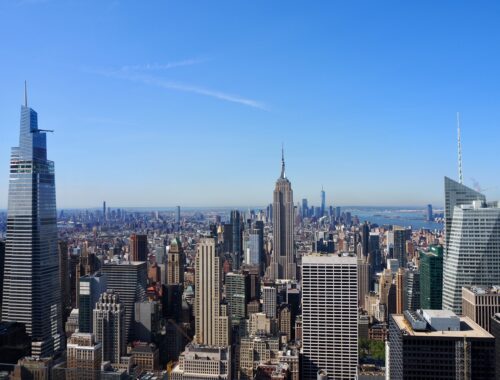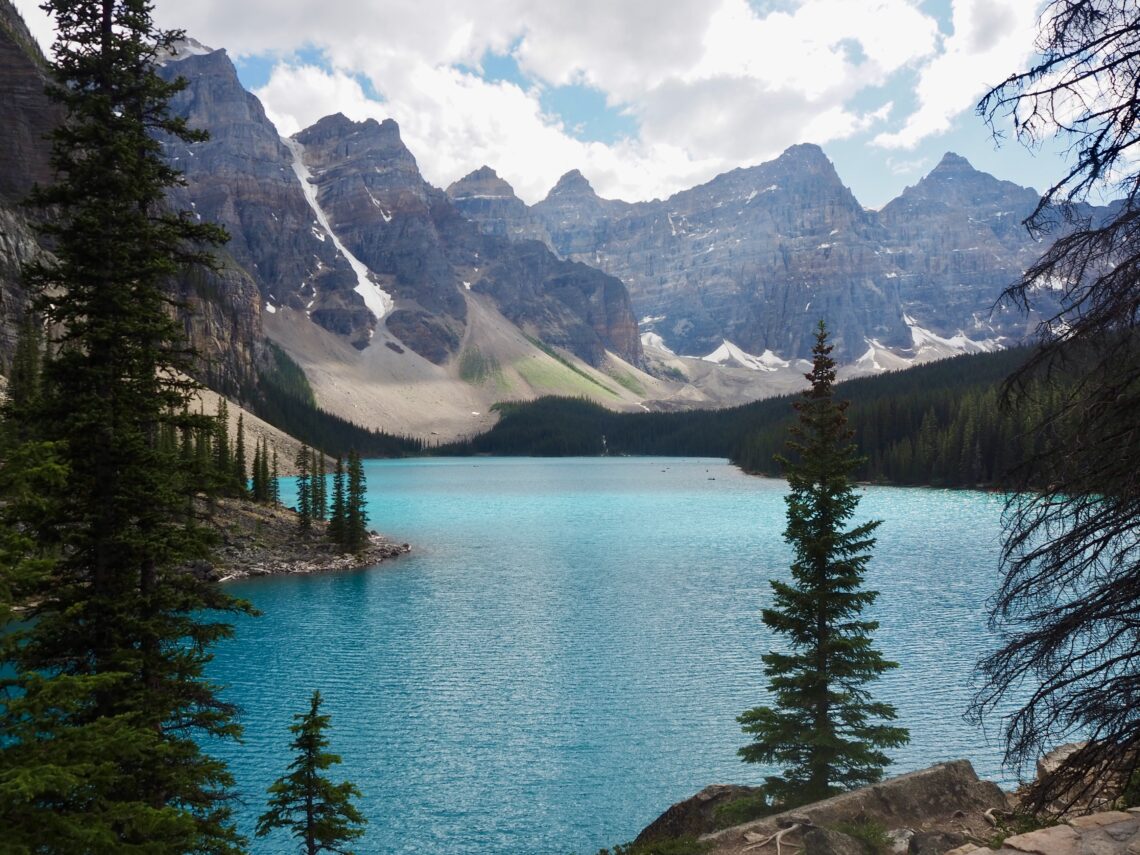
Banff National Park | Canadian Rockies
When Canada’s two most famous national parks are right next door to each other, it makes sense to visit both in the same trip! After our week in Jasper, we headed south down the Icefields Parkway to Banff National Park for another week. We actually spent 5 nights in Lake Louise village, followed by another 4 in Canmore, just outside the national park. I’ve combined this into one post though, since they’re so close. Banff wasn’t as snowy as Jasper and the mountains looked pretty different somehow – less peaks, more plateaus. And of course, Banff National Park has some incredibly glacial lakes!
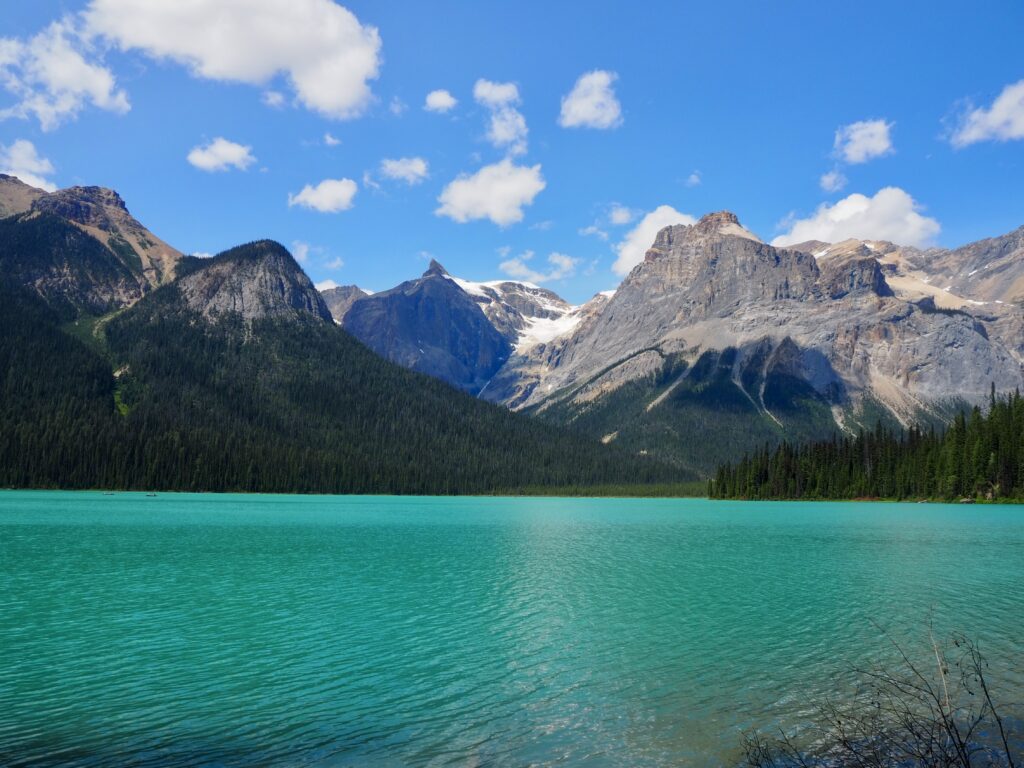
Day One
Athabasca Falls
After I finished work mid-week, we journeyed down the Icefields Parkway, thankfully open again after last weekend’s closure. We made a stop on the way to visit one of the sights we missed when we had to take the detour, Athabasca Falls. The Athabasca River is the main river flowing through Jasper National Park, starting at the glacier. The falls are about halfway between the glacier and Jasper town, and just a short detour off the main road. It doesn’t take long to walk over to them and see all the spray floating up into the air. After some of the waterfalls in Wells Gray Provincial Park, this was quite small in comparison, but a nice, easy stop-off.
The whole journey that evening took a couple of hours, passing the Athabasca Glacier again before crossing into Banff National Park. We went round the Big Bend, a wide curving stretch of road which I actually drove on the detour day, but enjoyed from the passenger seat this time. Lake Louise and Banff are the two main towns where visitors to the park stay, Lake Louise being the further north and the smaller of the two. We stayed at the Lake Louise Inn, in a small suite where we had dinner in that first night after arriving late.
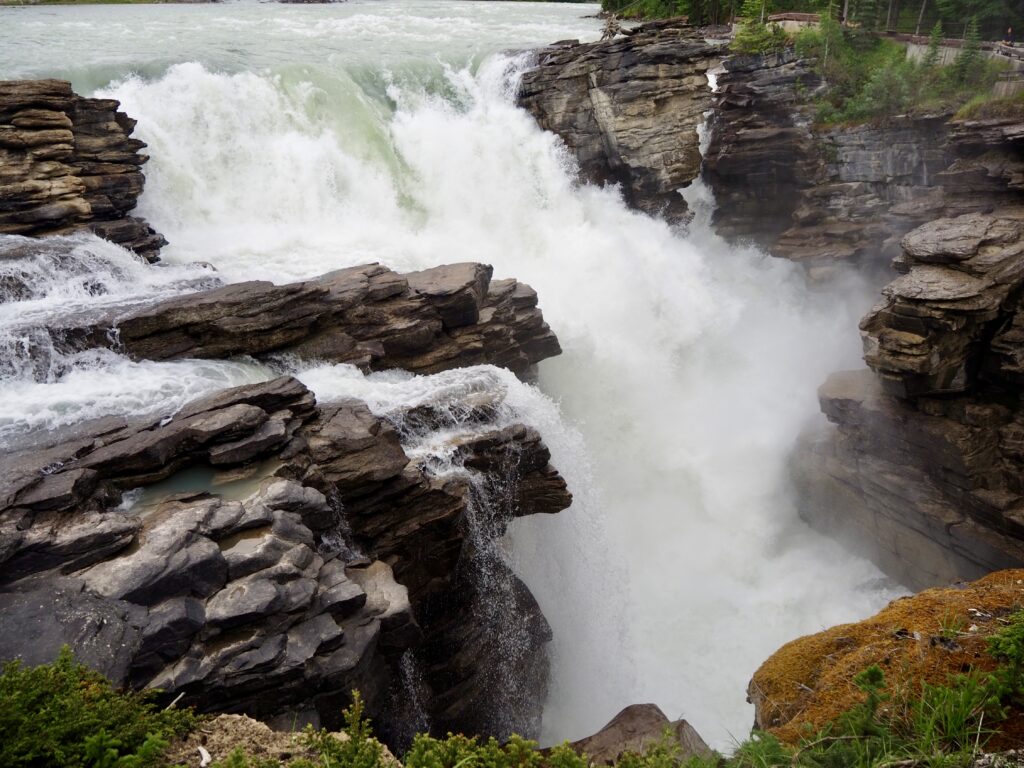
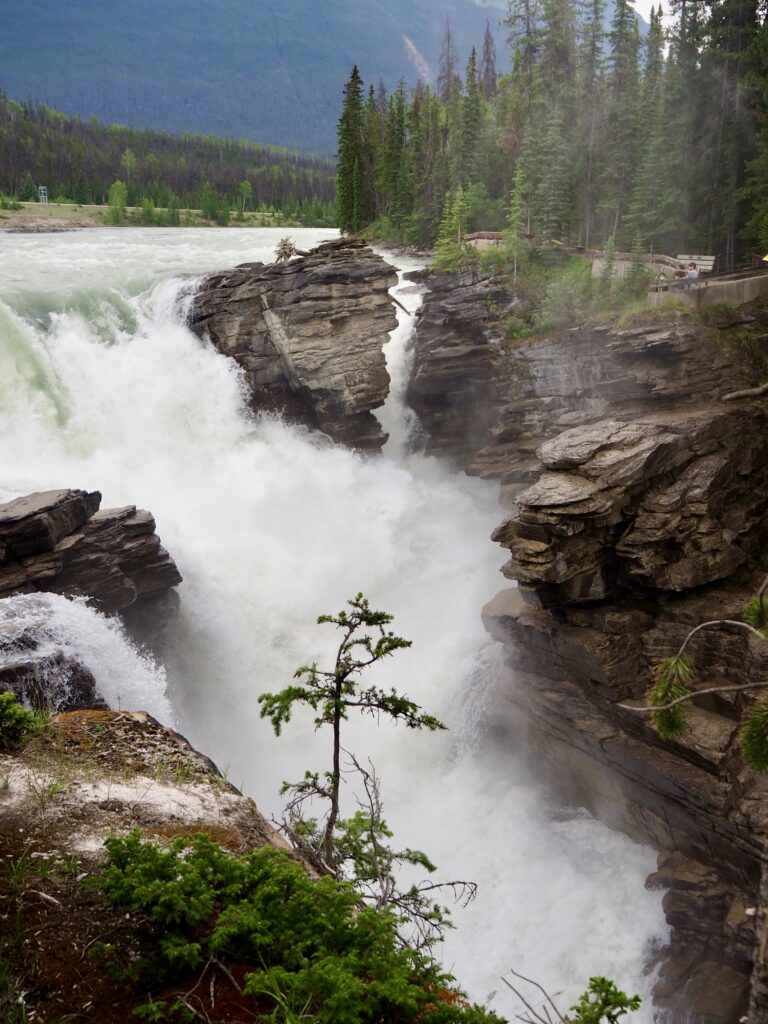
Day Two
Peyto Lake
Since we travelled down the road late the night before, we didn’t stop off anywhere else on the way down to avoid arriving in Lake Louise too late. So, the next day we hopped in the car after I finished work to head back up the Icefields Parkway again to see what we missed. I’d gotten a few recommendations from friends who’d visited the area earlier in the year, and Peyto and Bow Lakes were places they highlighted as worthwhile stops on the way.
We started at Peyto Lake, where you have to turn off the Parkway and take a smaller road up the mountainside. It took us a mnute to find the right ath from the car park to the viewpoint, as there’s another trail nearby that goes higher up, which we weren’t loking for. Once we did though, it was a short walk through the treees to the large viewing platform above the lake.
What do you think it looks like? The shape didn’t actually occur to me immediately – I was too busy being enthralled by the striking blue colour! But then I overheard someone say it was a fox, and suddenly noticed what they meant. I later saw descriptions that compared it to a wolf or dog as well. Whichever animal you pick, it certainly makes for a unique shape! The platform was pretty busy with people posing for photos, so we snapped ours, admired it for a while and then headed back to the car.
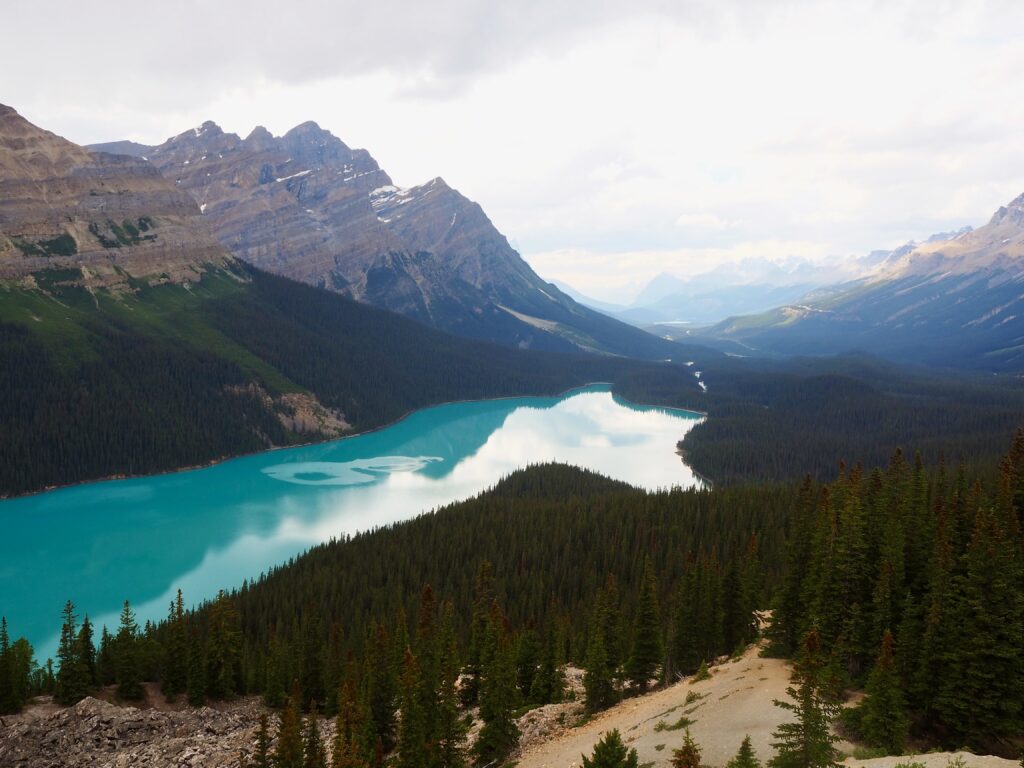
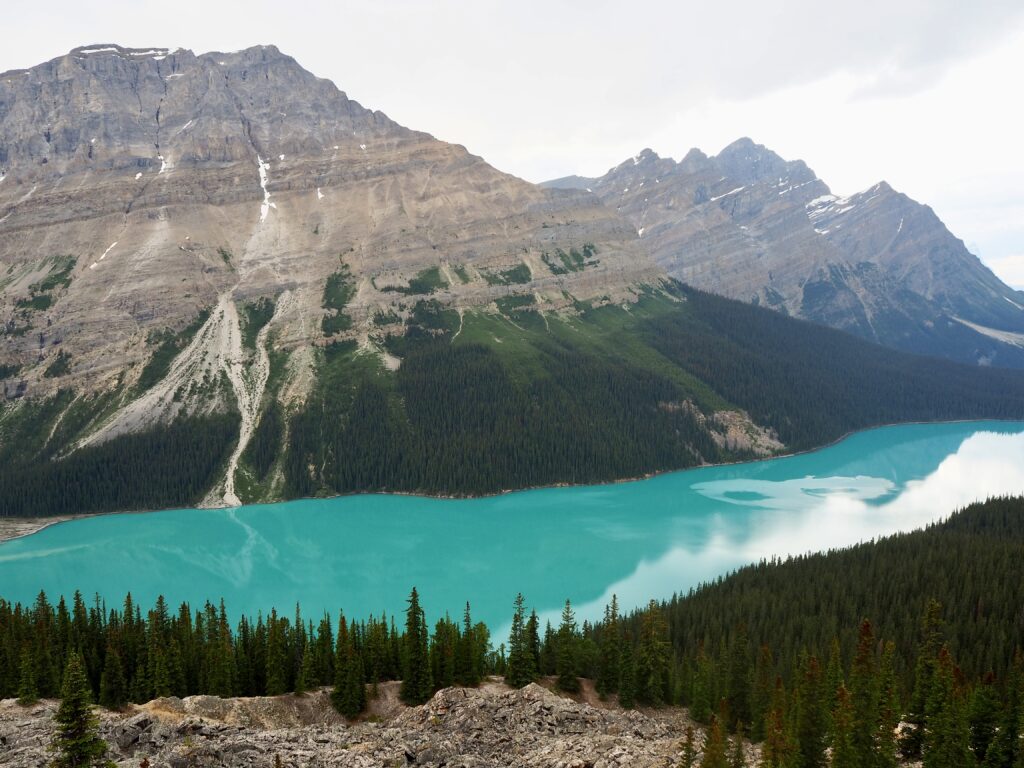
Bow Lake
Just down the road from Peyto Lake, is Bow Lake, another blue glacial lake, nestled amongst the mountains. We could even see the glacier high above this one, creating the blue colour with its rock flour. You can get to the shore of Bow Lake, where we parked and then went for a wander along the shoreline. It was quite busy right next to the car park, but along the road was much quieter and that’s where we got the btter view of the glacier. I also slipped my shoes off to go for a quick paddle – a theme which will continue throughout the next few lakes coming up!
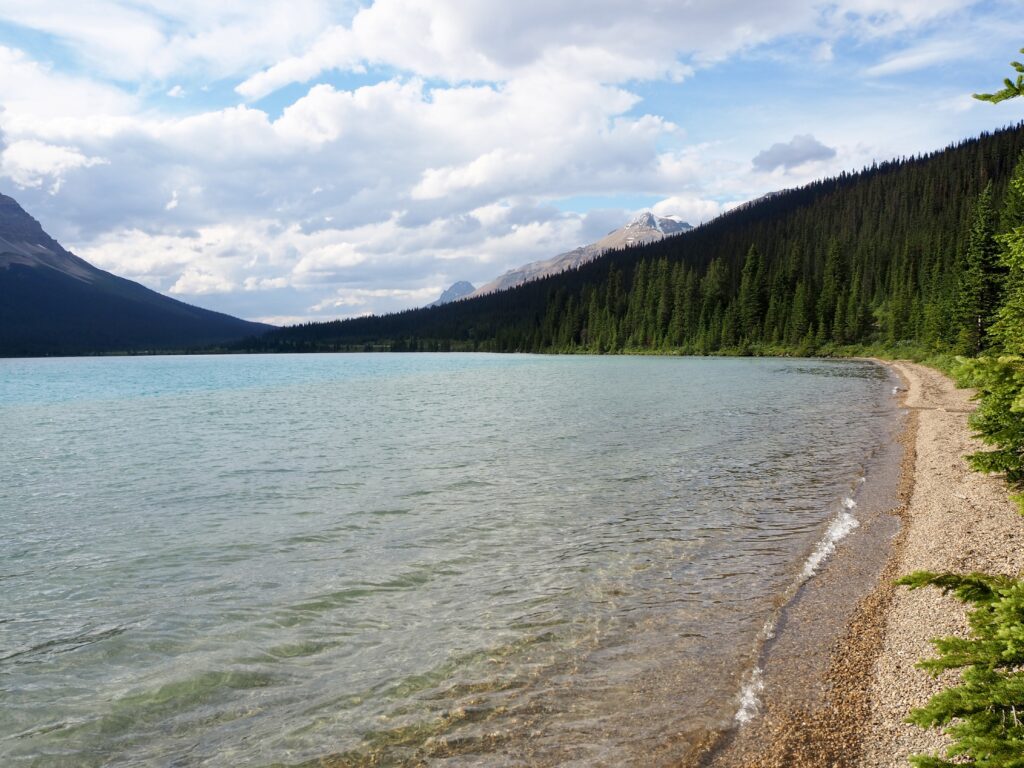

Day Three
Lake Louise
Our time in Banff National Park coincided with a public holiday, which meant it was very busy, but also that I had an extra day off work to explore on the Friday! We decided to start with the most famous lakes and the biggest draws to the national park, Lake Louise and Moraine Lake. You can only access the latter via shuttle bus and we had no luck whatsoever getting the official Parks Canada one, after I woke up early and went online when the tickets released. they were gone in seconds! Fortunately, the hotel had a private shuttle that operated, and we managed to snag seats. You can drive your own car to Lake Louise, but parking is a nightmare, so we opted to take the shuttle for that too. Lake Louise was up first, just since that’s the shuttle time we could get!
We headed out early and it’s about a 10-15-minute ride from the village, dropping off near the huge Fairmont castle-style hotel. The lake itself is huge, stretching into the distant mountains that surround it. The water is a turquoise on the green end of the spectrum, and it’s very cloudy water which means there’s more rock flour in it than others. The shoreline was packed with people taking hophotos, but the further you walk around the shore, away from the hotel, the less congested it gets. The water is also dotted with red canoes, hired from the hut on the shore, but the queue was massive so I skipped that. A few people had brought their own paddleboards or kayaks as well.

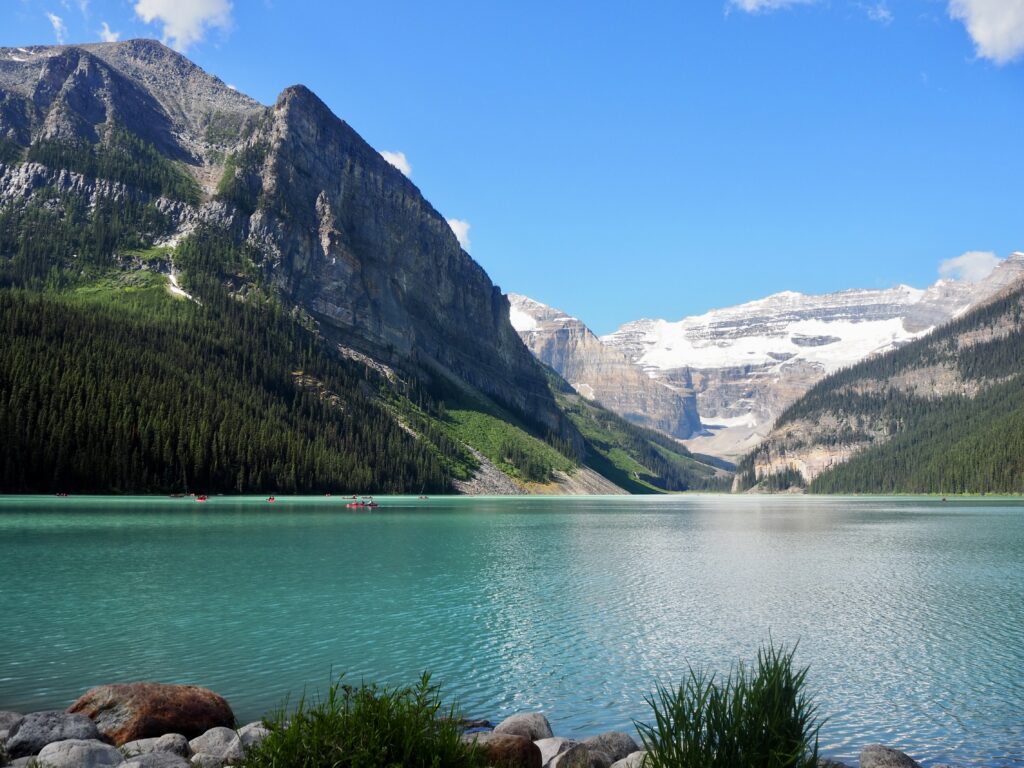

Lake Agnes Tea House
I wanted to get some hiking in while in Banff National Park, and the Lake Agnes Tea House hike was one we’d heard good things about from a few people we’d met along our trip so far. It’s also one of the mid-length hikes, taking 2-3 hours for the round trip. Mum even joined for it, and she can’t usually hike loads because of her knees and feet, but her new hiking poles helped. The hike is pretty vertical – you climb a trail ascending as you follow the lakeshore, until a switchback continues to bring you higher. You’re in the forest though, so you can’t see much of the lake, except the green peeking between the trees.
The path then heads away from Lake Louise, passing by the small Mirror Lake. This sits below the Big Beehive, a dramatic rocky stack overhead. Continuing on, there’s a fork where you can go the direct route to Lake Agnes, or detour to Little Beehive. Lake Agnes has crystal clear blue waters, sitting just above a waterfall. The tea house seems to balance on the edge of the falls next to it! It’s been there for over a hundred years, said to be the oldest tea house in Canada. It’s quite the operation too, with staff hiking up supplies regularly and a helicopter supply drop-off once a year. There’s also no electricity so everything is done by hand! It’s a family business too, with even the grandkids taking orders on their summer holidays.
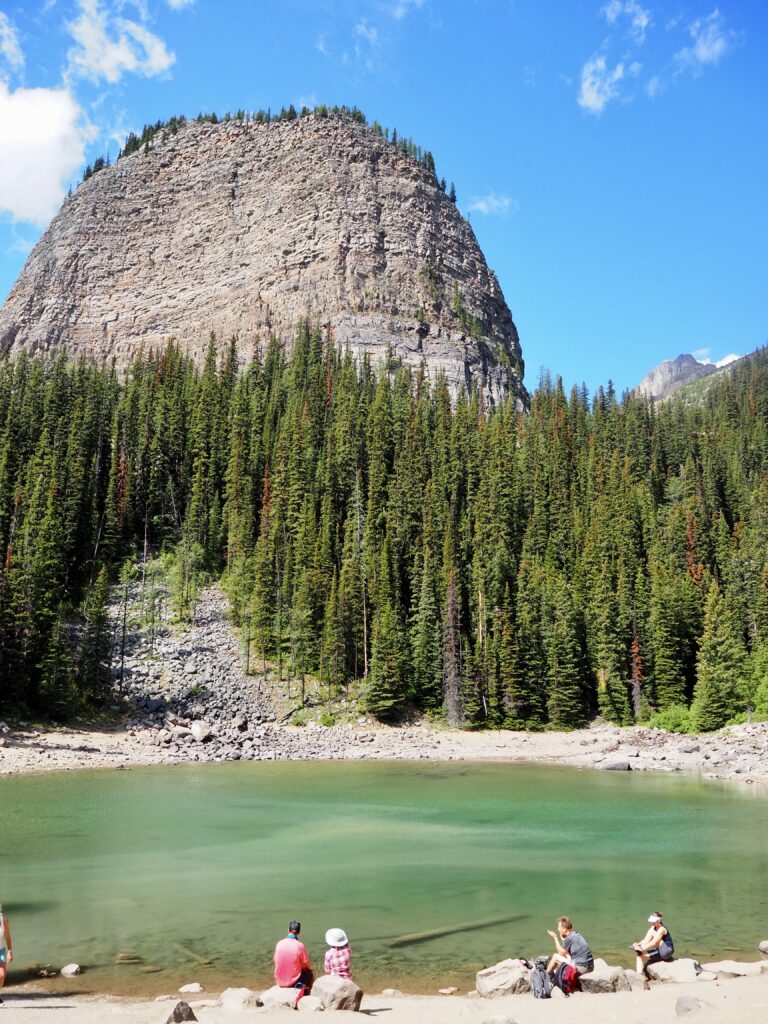
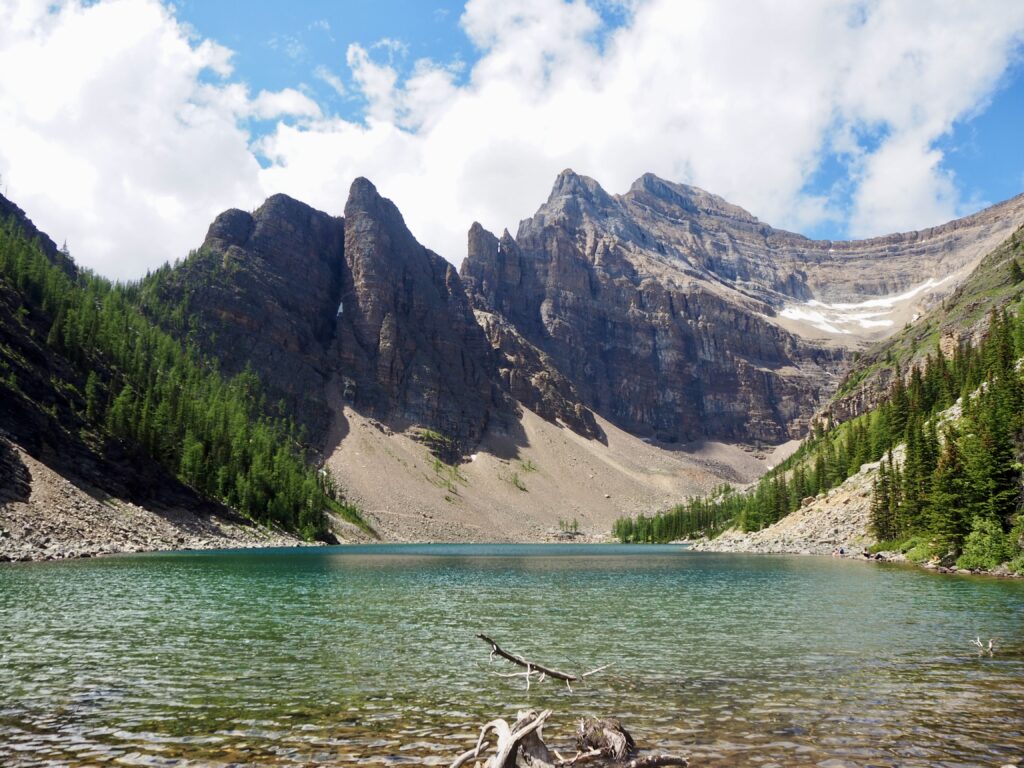

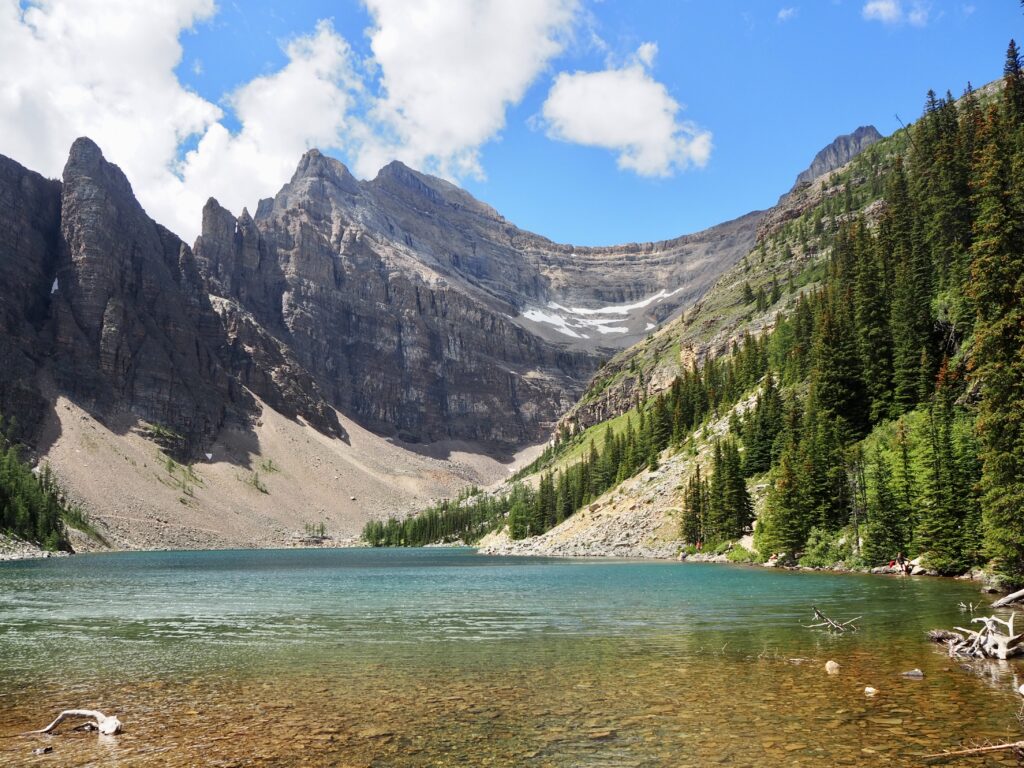
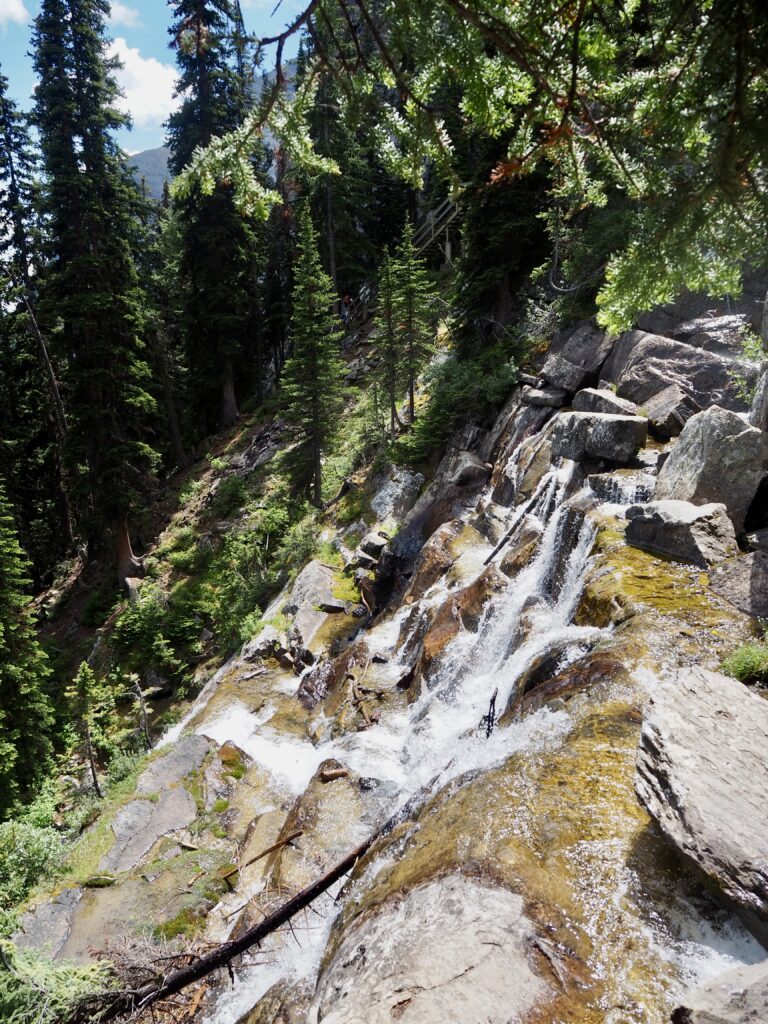
Little Beehive
As I mentioned, there’s also a detour to Little Beehive, which Dad and I took before meeting Mum at Lake Agnes. It only added about half an hour to our journey (depending on how long you look at the view) and was a similar rocky path as the rest of the trail so far. It was a hot day though, and I was pretty exhausted and out of breath by the top!
Now, Lake Agnes is beautiful, but you can’t see Lake Louise from it. Little Beehive, however, overlooks the whole valley, with the bright emerald streak of the lake looking striking from above, surrounded by the dark mountains. You can see further down the valley, where the main road runs as well. The whole thing is just stunning and so impressive! It was a much quieter trail than the rest of the Lake Agnes one, and we only saw about half a dozen other people at the viewpoint. It’s definitely a worthwhile addition if you’re doing the Lake Agnes hike anyway!
After heading round to Lake Agnes to meet Mum and have lunch at the teahouse, we retraced the trial back down to Lake Louise. We had a little bit of time before the shuttle bus back, so we just sat by the lake to enjoy the view. And, of course, I went for a quick paddle in the icy water!
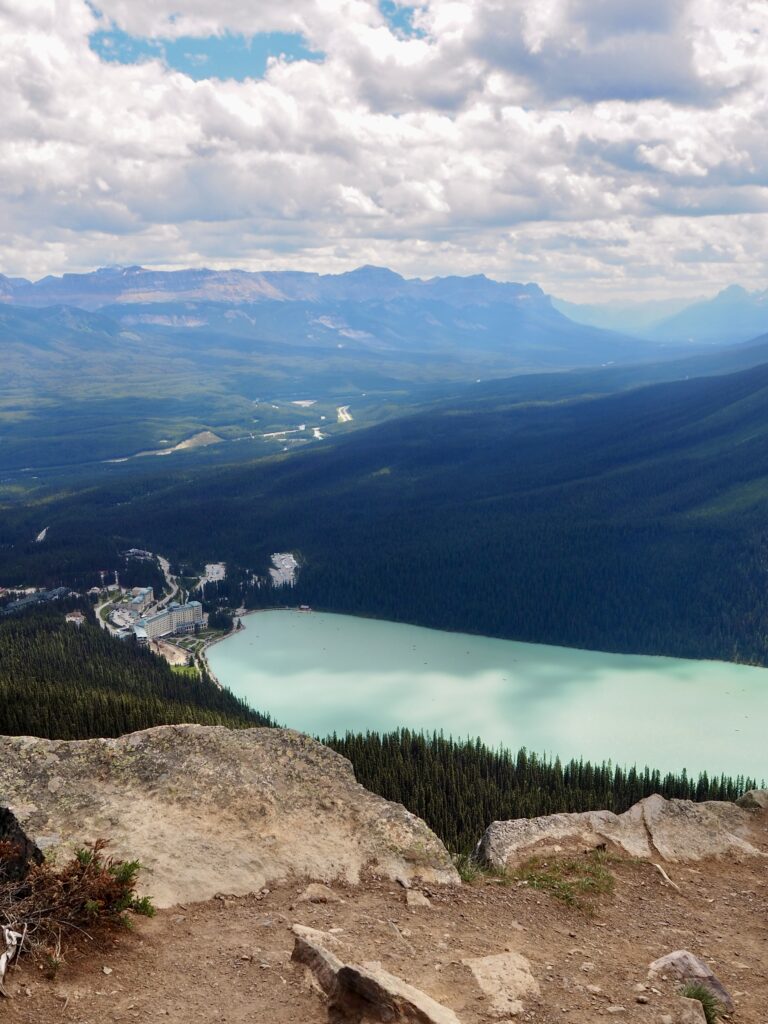
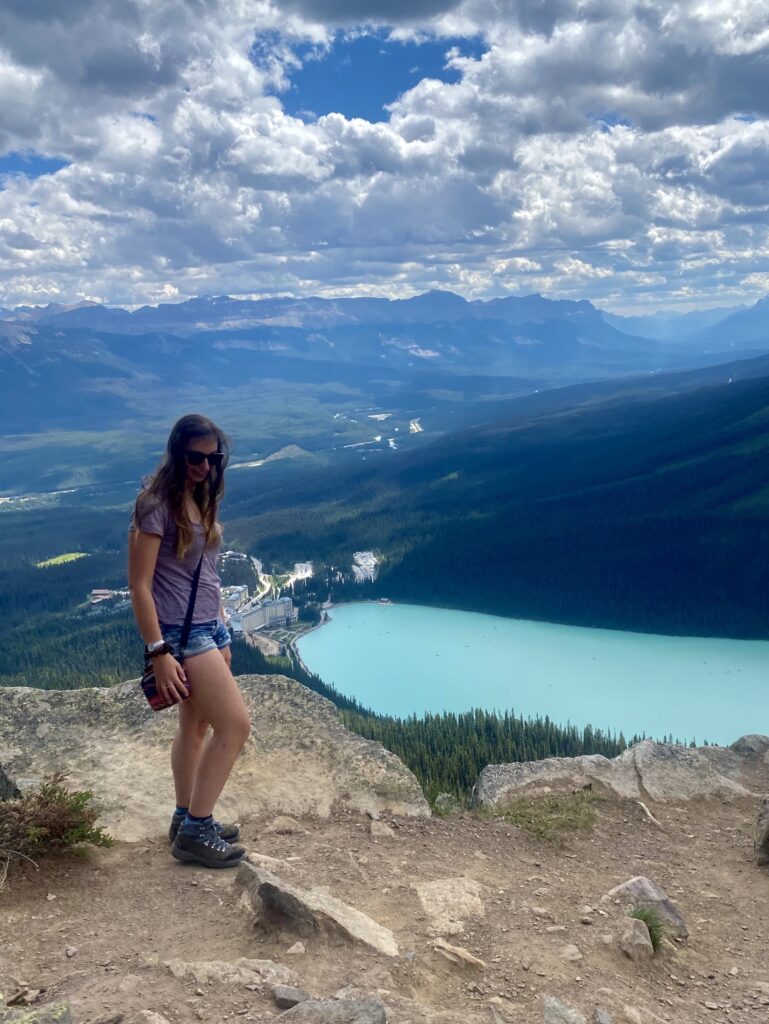
Moraine Lake
We returned to the Lake Louise Inn, had a quick rest in the room, and then were back on the evening shuttle out to Moraine Lake. At one point (when I was stressing about getting shuttle tickets), Dad did ask if we needed to see both lakes. Once he saw both though, he quickly understood why yes, yes we did. Going to Moraine Lake in the evening was actually a great idea in the end, as it was so much quieter compared to Lake Louise. I believe sunrise is popular with photographers for the light, with the direciton of the sun, but we still got some incredible lake colour in the evning too!
We climbed the Rock Pile first, a short but steep hike. This is where you get the most iconic views of Moraine Lake. Striking, sky blue water, tall conifers spiralling up in the foreground and imposing, barren mountains surrounding it. We hung out here for a while, soaking in the view, then headed down to the shoreline. We found a bench for our picnic dinner, chasing away the chipmunks that came scrounging. And, I went for a paddle. I actually waded in to above my knees this time, since it wasn’t as cold as I expected!
Dad and I then walked the trail along the shoreline, which only took about half an hour each way. It’s a pretty flat trail through the trees, with plenty of benches and beaches along the way. The end is a boardwalk that takes you along to the lake’s source, the water tumbling down over the rocks. We could also see the glacier up above as well, both the summer ice level and the cavity it fills in winter. The trail was very peaceful with hardly anyone still around!
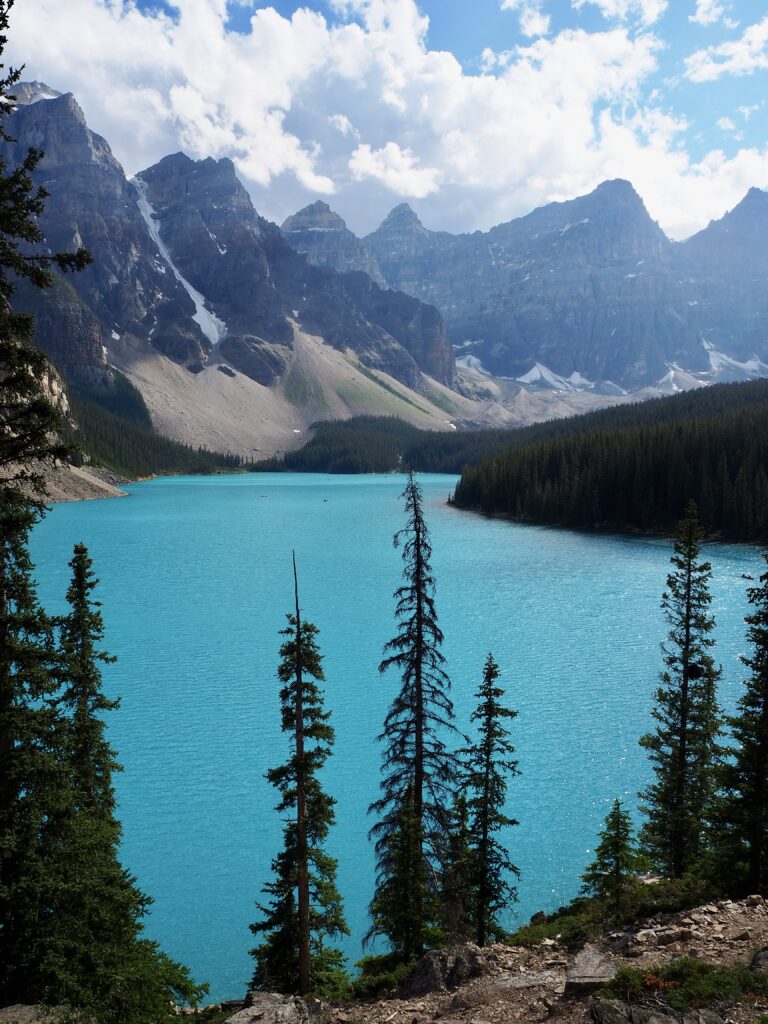
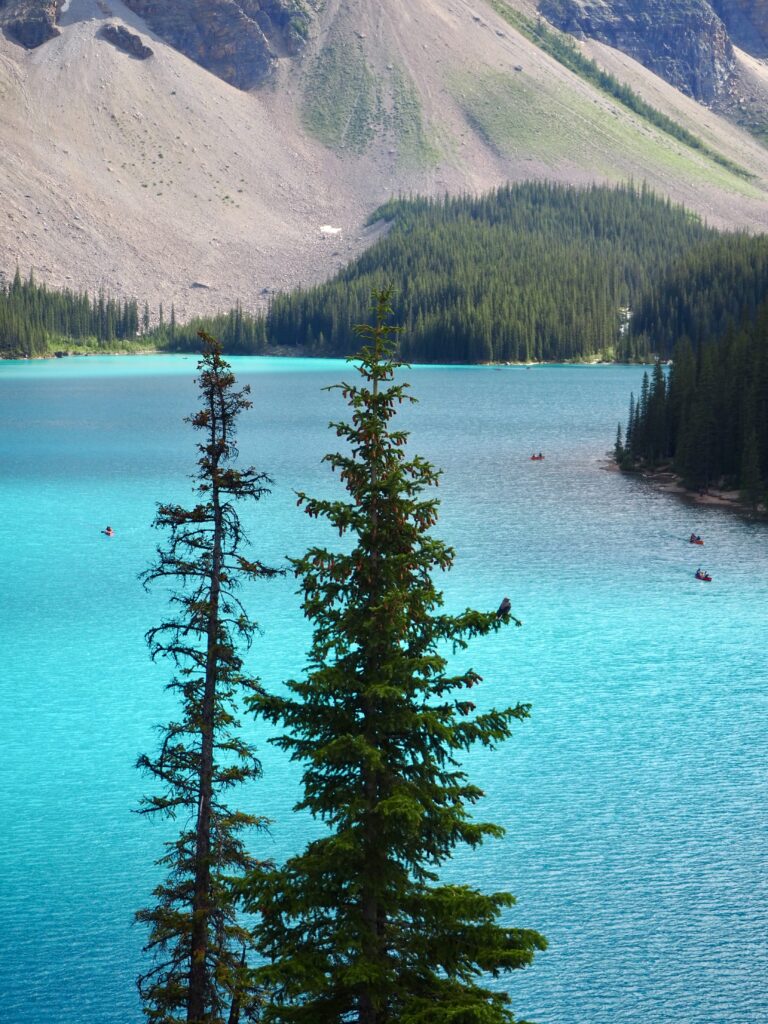

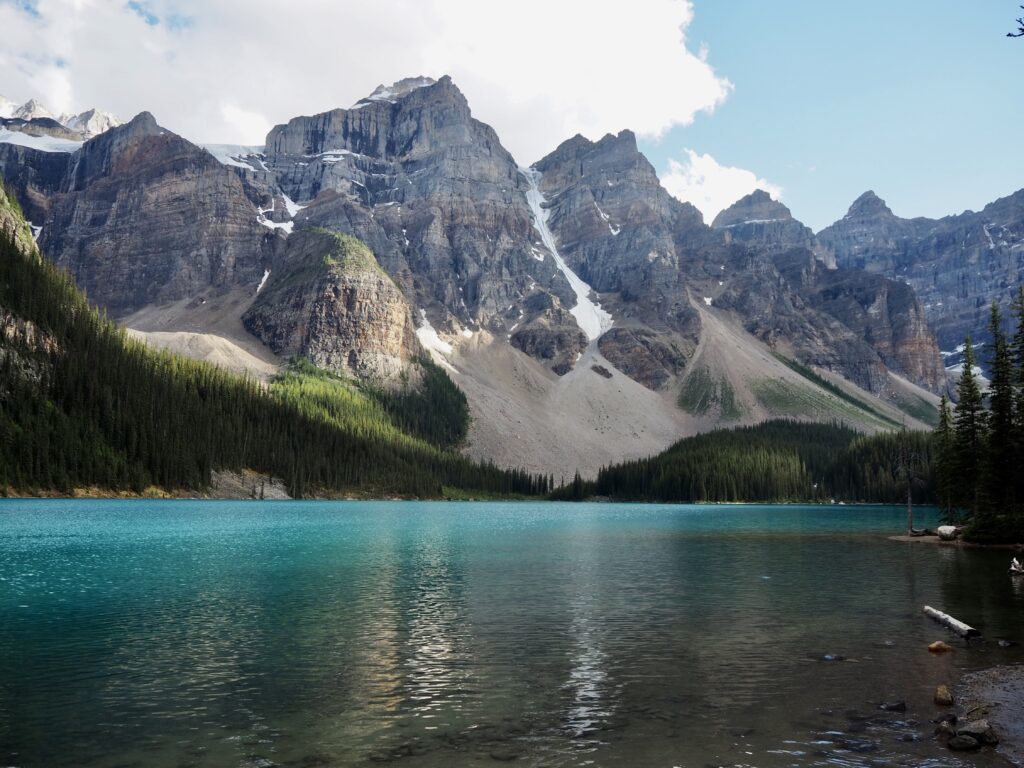
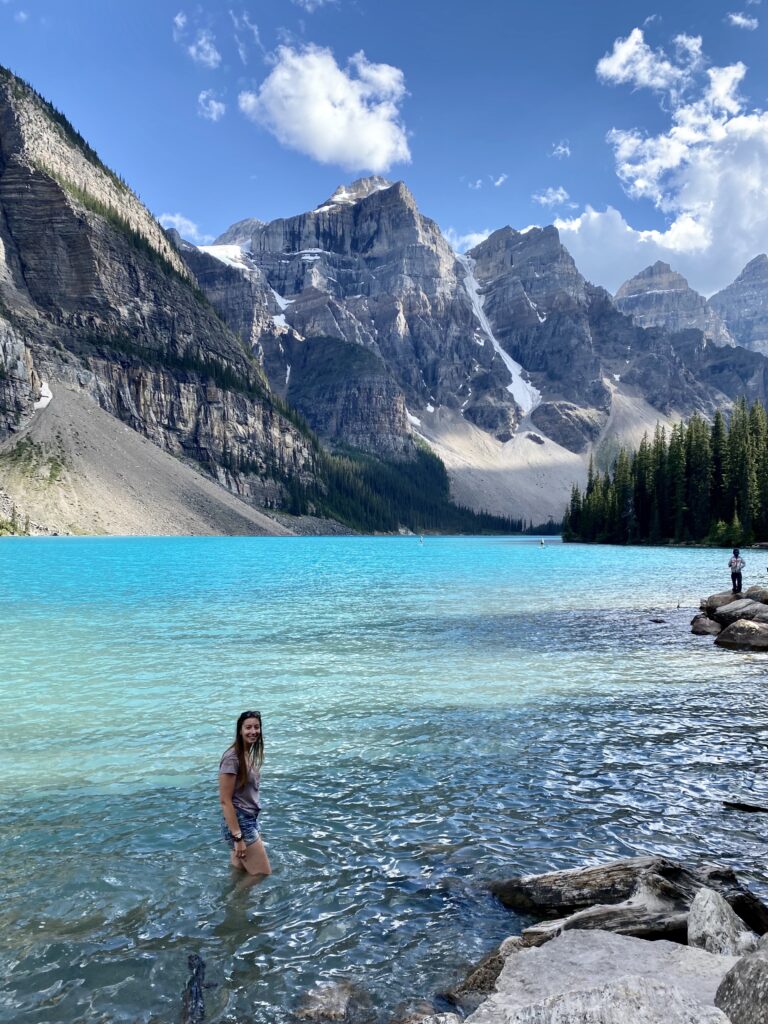
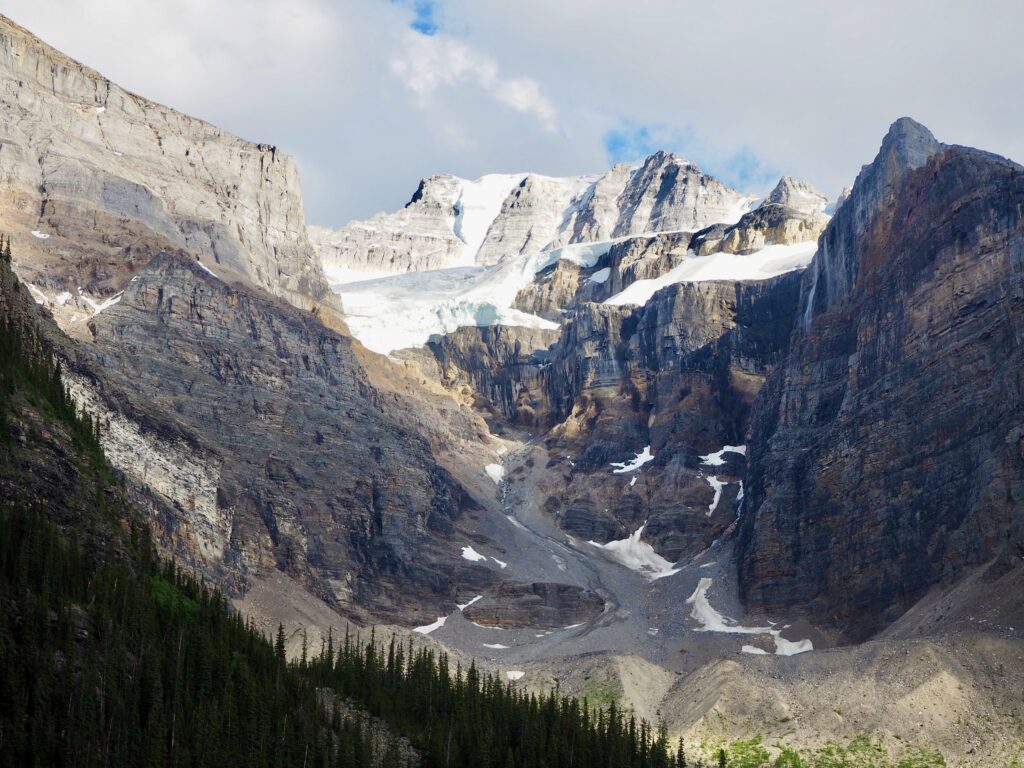
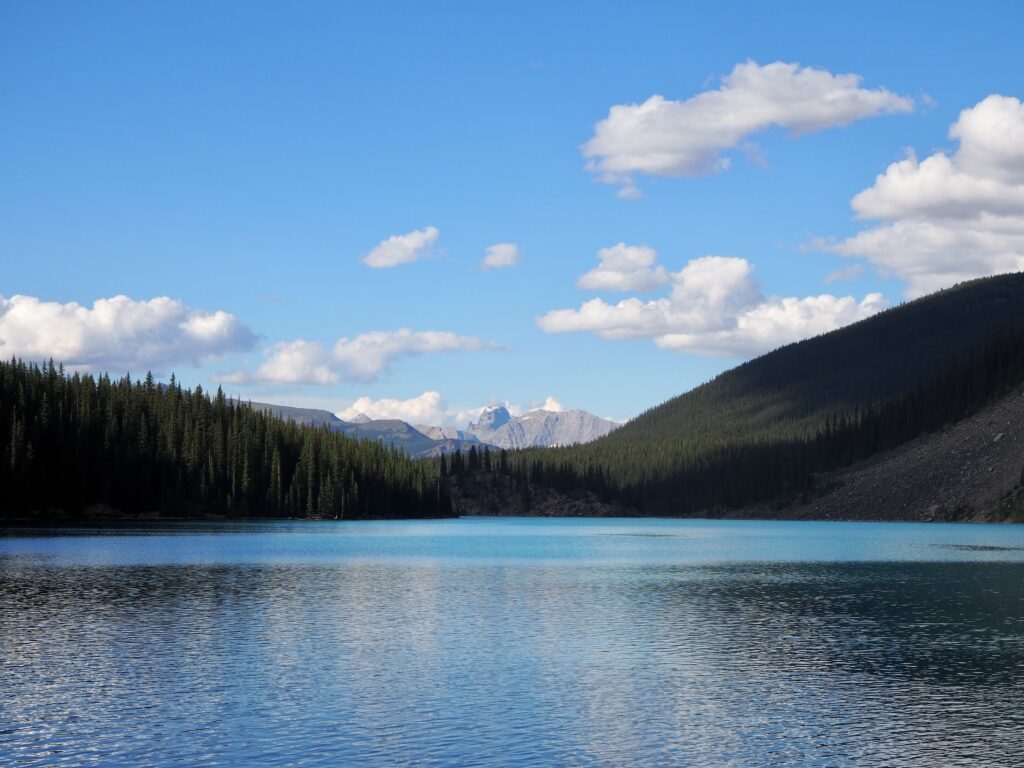
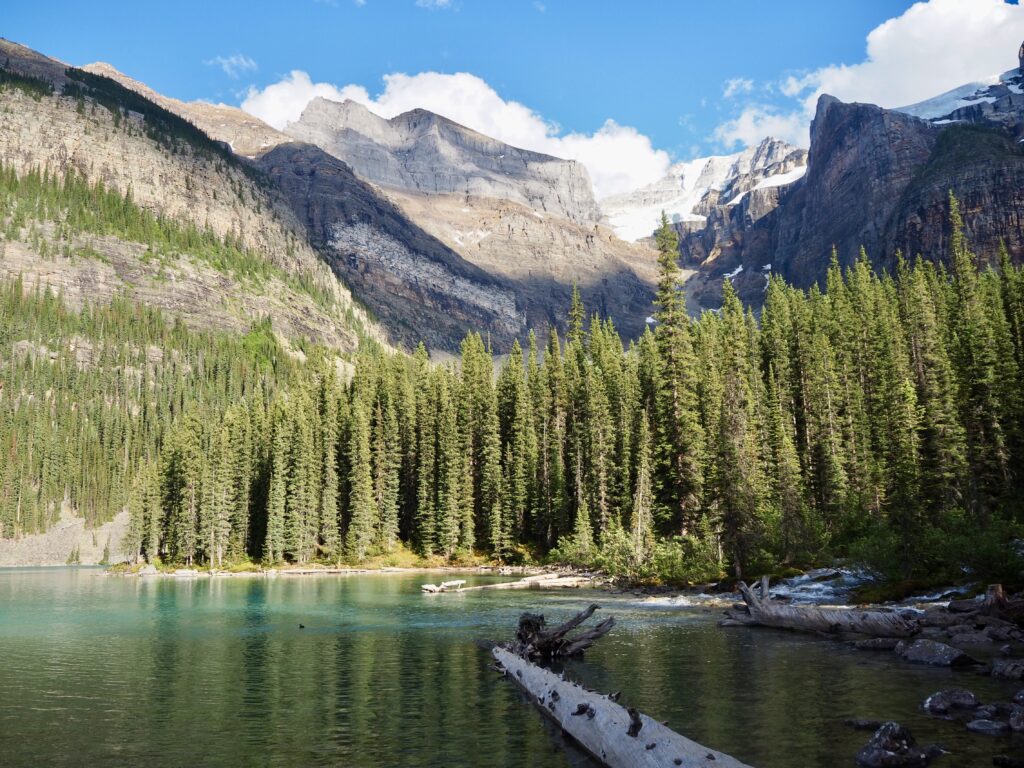
Day Four
After seeing the big-ticket lakes, we turned our attention to the other sites of Banff National Park. As I mentioned earlier, it was a public holiday weekend, specifically Canada Day. So, everywhere we went today was very busy and it took a while to find parking each time! I would recommend coming a different weekend in future!
Johnston Canyon
Anyway, we headed out of Lake Louise and followed the road east towards Banff town. Our first stop was Johnston Canyon, a gorge carved out the rockside by a river, with several waterfalls along the way. We picked this so Mum could walk to at least the Lower Falls and then decide if she wanted to go further or turn back and wait for us (she did the latter). The path was super busy, since it was narrow too, but the river flowing down the canyon through the forest was so pretty I also had a moment where became very aware of how different the forest was here compared to the temperate rainforest I’ve gotten used to in BC! There seemed to be a cave or lookout by the Lower Falls, but the queue was so long that we didn’t bother.
Instead, Dad and I continued upstream, following the trail past half a dozen more waterfalls of varying sizes. It was an easy path to follow, but the uphill did tire me out a little. We eventually reached the walkway suspended over the river to see the Upper Falls. But we had to wait in line for about 20 minutes, as the platform was too small for more than one group at a time. We’d made it this far so we waited it out – the falls were nice, but not spectacular. We then explored a little further up the trail, where we discovered a second platform, this one overlooking the falls from above. Had we known earlier, we’d have just gone to this one and skipped the other! But oh well. We then hd to retrace our route back downstream, to find Mum at the start again.
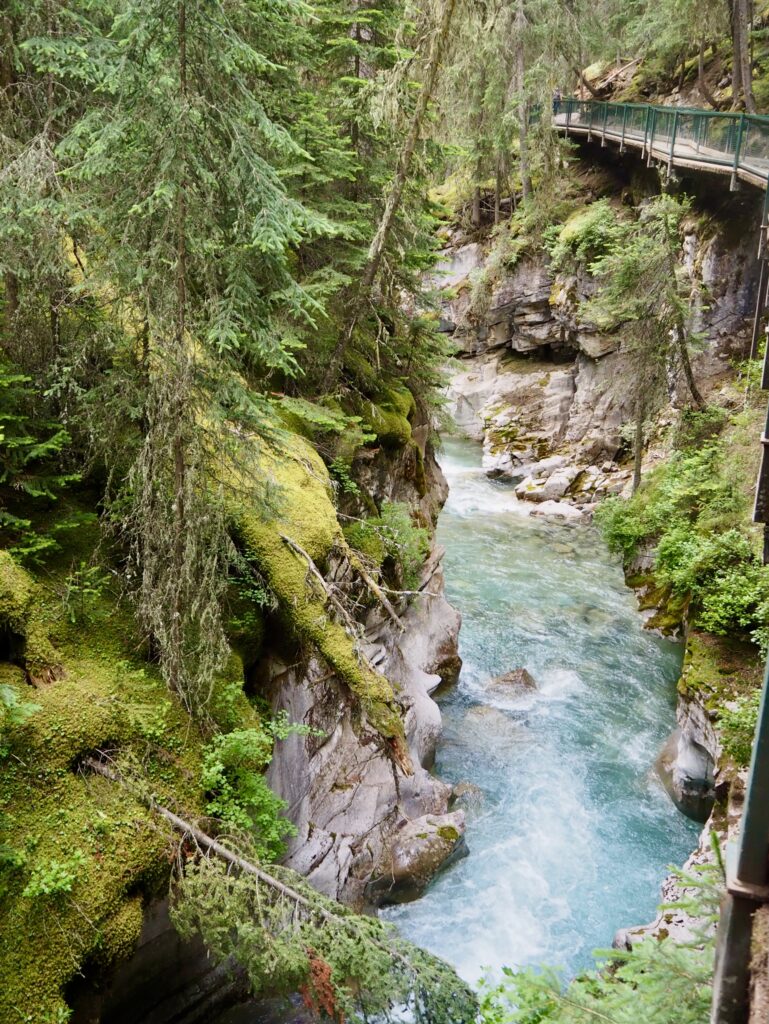



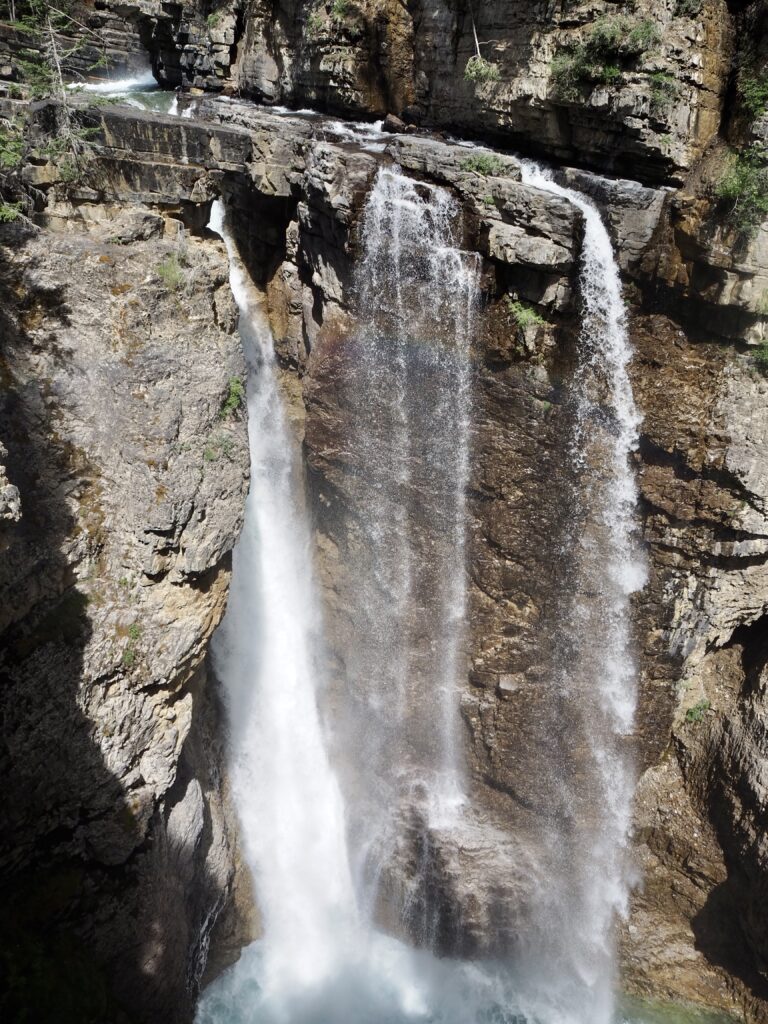
Mount Norquay Viewpoint
Our next stop was considerably less busy! I stumbled upon this viewpoint on a blog somewhere and it turned out to be a good find! On the approach to Banff town, we turned off the highway to the left instead, following signs for Mount Norquay. The road is a series of tight switchbacks up the steep mountainside, until you reach a lookout point where you can park. There’s a gap in the wall to enter a neighbouring field, where a lot of people were having picnics.
The view is, of course, the main attraction. From here, you can see all of Banff town and the valley we’d just come down, surrounded by mountains. Sulphur Mountain is the big one next to Banff, and after a few minutes of staring, we spotted the gondola to its peak. Since we were seeing the view from this side, we didn’t feel a need to see it from the gondola side too! There’s also Tunnel Mountain next to the town, which I’d thought about hiking but skipped in the end after yesterday’s effort.
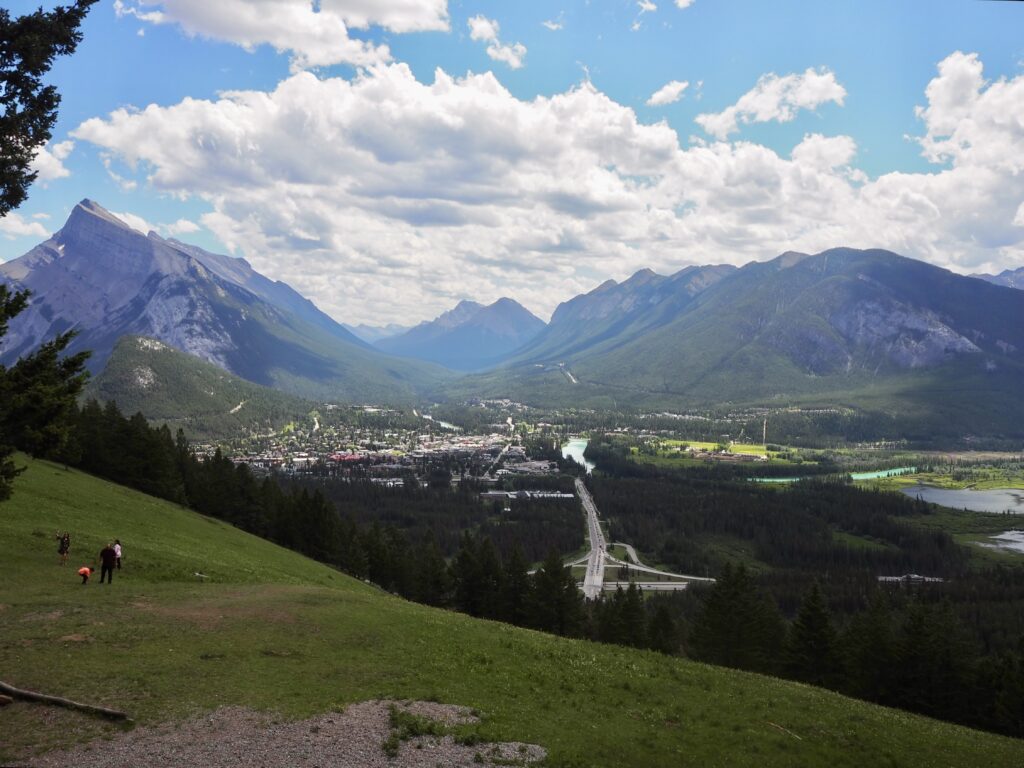
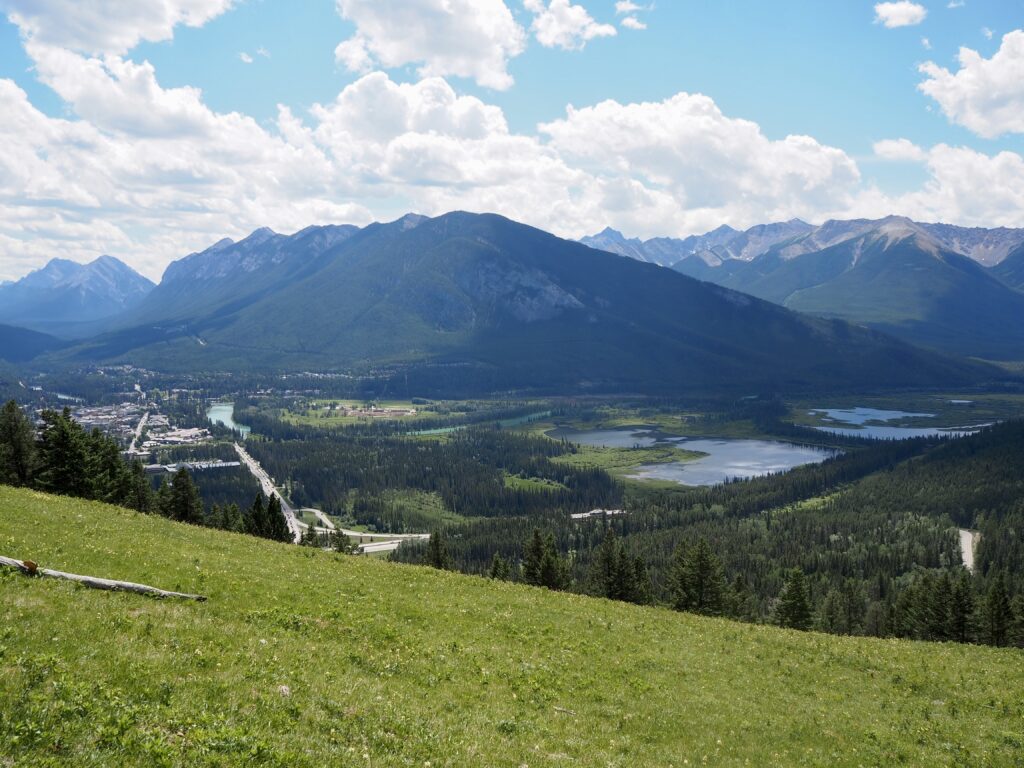
Lake Minnewanka
Next up, we continued down the road past Banff, in search of yet another lake. Lake Minnewanka doesn’t get quite as much attention at the other lakes in Banff National Park, but it was certainly popular enough that weekend! There are boat trips across the lake, but since we’d done Maligne Lake back in Jasper, we didn’t feel the need to do another. It took us a while to find parking, eventually nabbing a spot on the roadside. We then walked along the road until we found a spot to clamber carefully down the rocky slope. The road is too high to be by the shore, so no paddling this time! Instead, we settled on a ledge overlooking the lake for our picnic lunch.
Lake Minnewanka makes an interesting curving shape through the landscape (check it out on a map!) so you can really only see part of it from the shore, before it snakes round a corner. It’s another glacial lake, so bright blue scenes awaited us, with gravel-like scree mountain slopes around it. I think Banff’s mountains have less trees in general than Jasper’s. We watched people boat and paddle across the lake in various vessels under the midsummer sun. It was a peacfeul little spot we had found in the end. We took a drive along past Two Jack Lake on the way back to Banff too, where we saw wild sheep by the roadside!
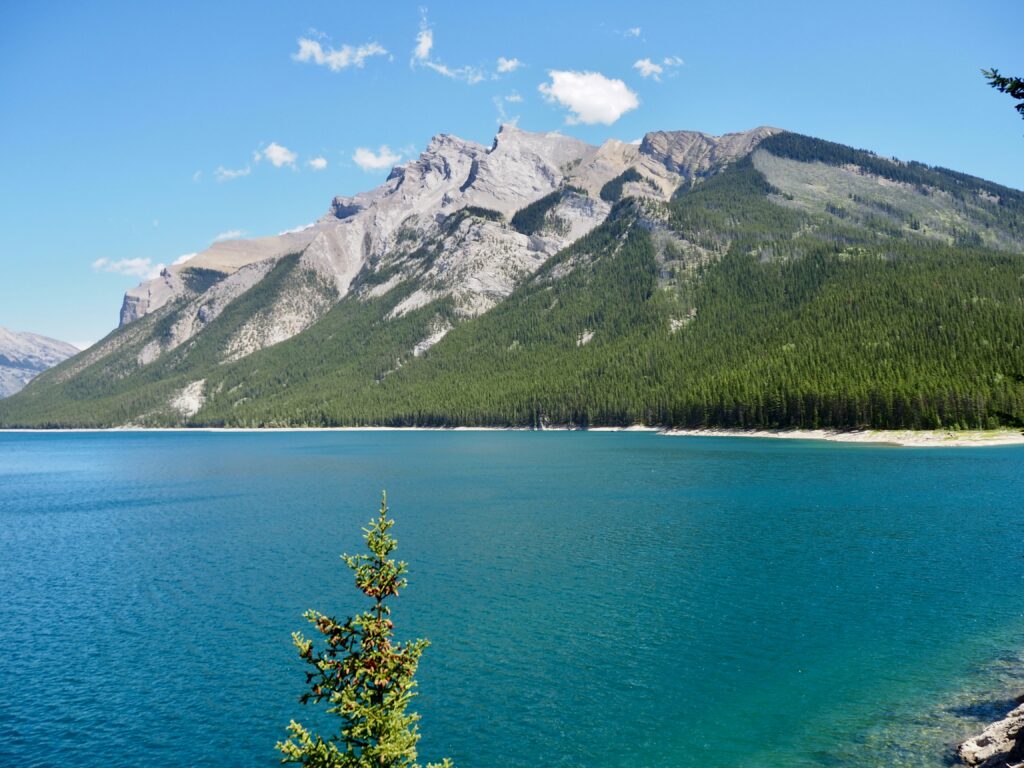
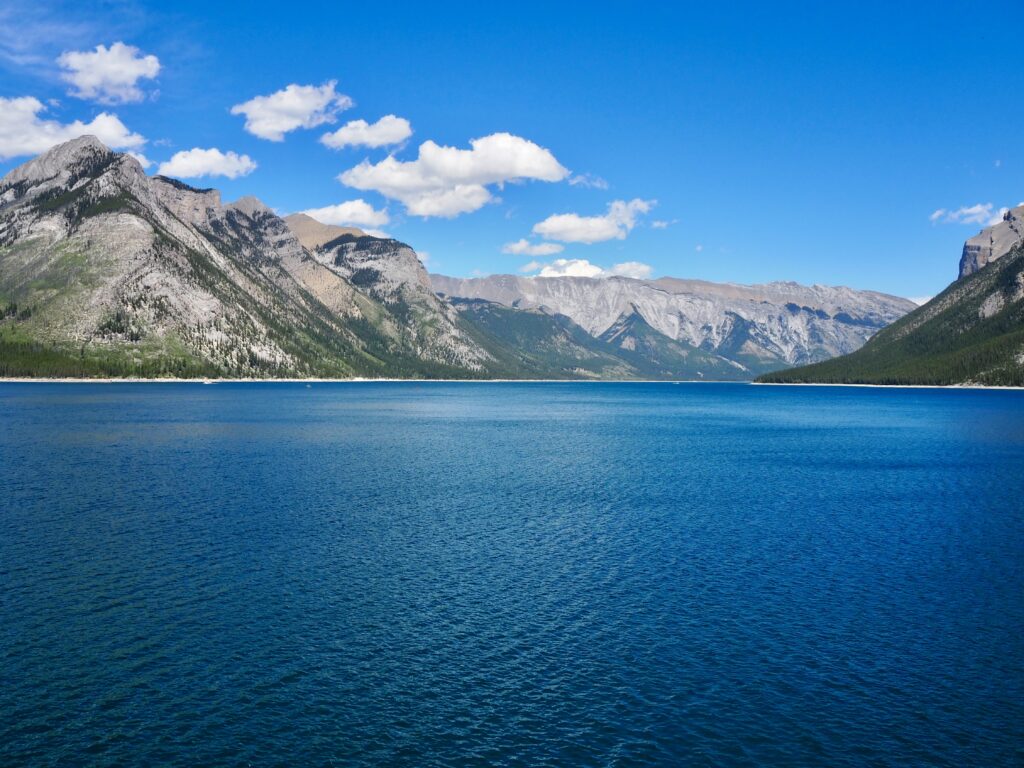
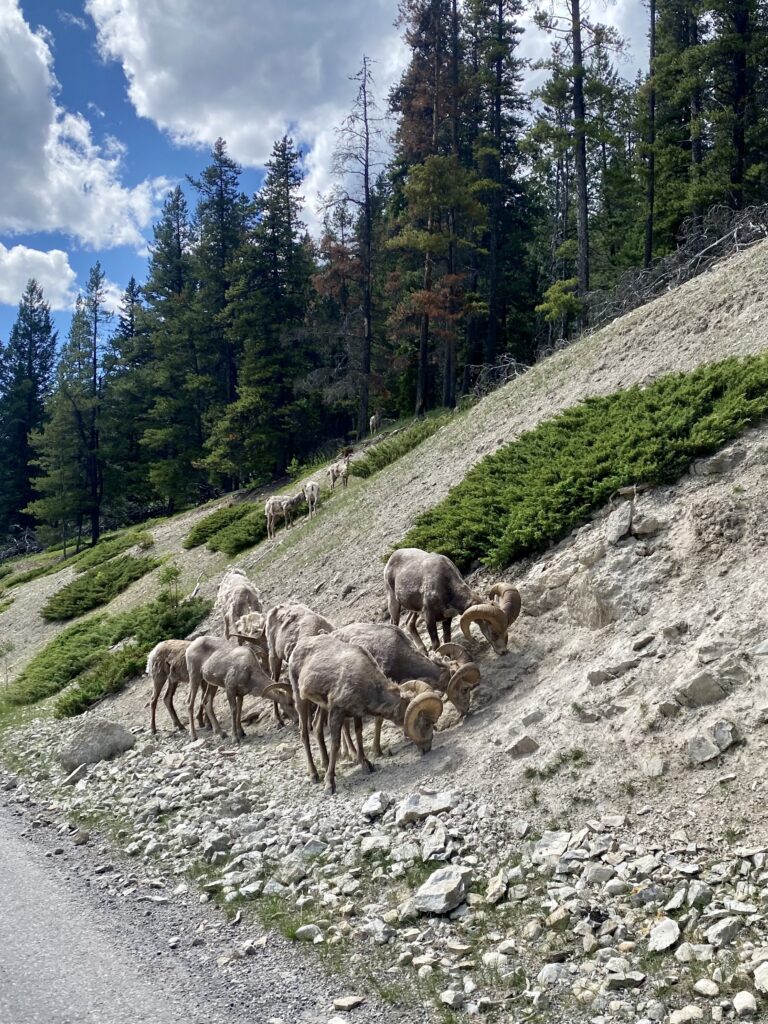
Canada Day in Banff
Finding parking in Banff on Canada Day wasn’t actually as bad as we were expecting! I think because we arrived late in the day, and most of the events only had an hour or two to go. The town is full of mountain cabin-like buildings, with a pedestrianised main street full of shops and restaurants. We went for a wander and quickly found a green with Canada Day events going on. We arrived just in time for a group of First Nations people to put on a performance of their music and dance, in their traditional regalia. They also explaied the meaning and significance behind each dance as well, so it was great to get a cultural, learning experience.
After they finished, we wandered down the main street, just looking around, and caught the last few minutes of a marching band’s performance. I think they might have been the Calgary Stampede Showband, but I only realised that the following week at the Stampede! After they finished, we found a small craft and farmers market nearby and had a browse around there. We came back into the town for dinner too, after our final activity of the day.
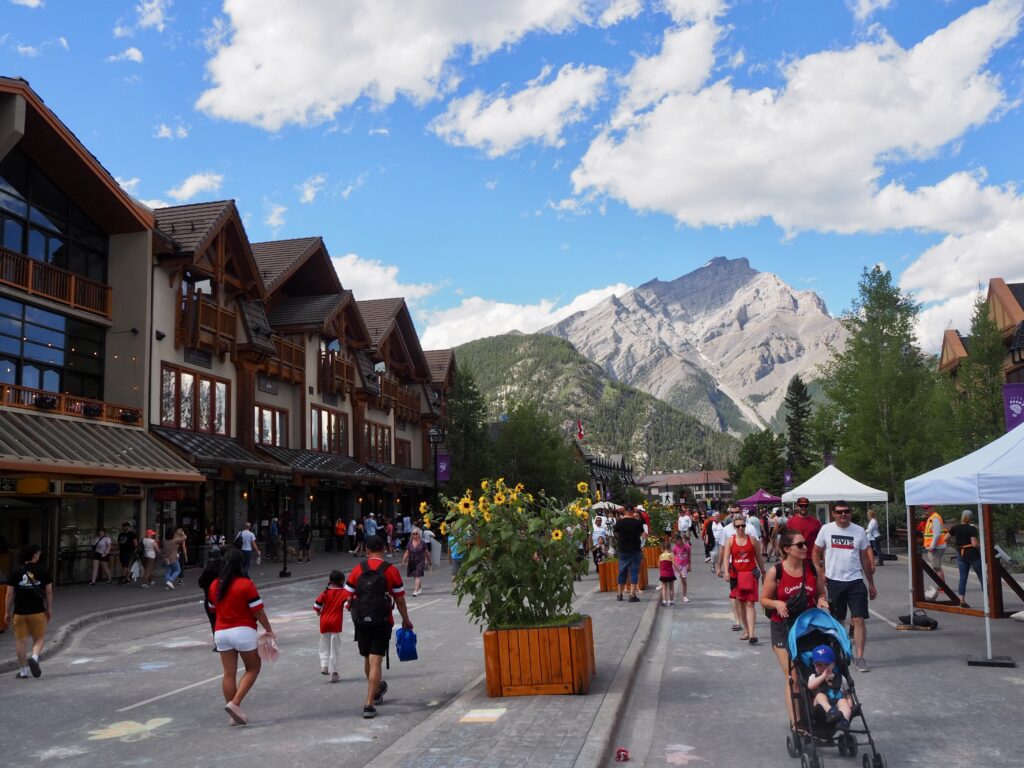
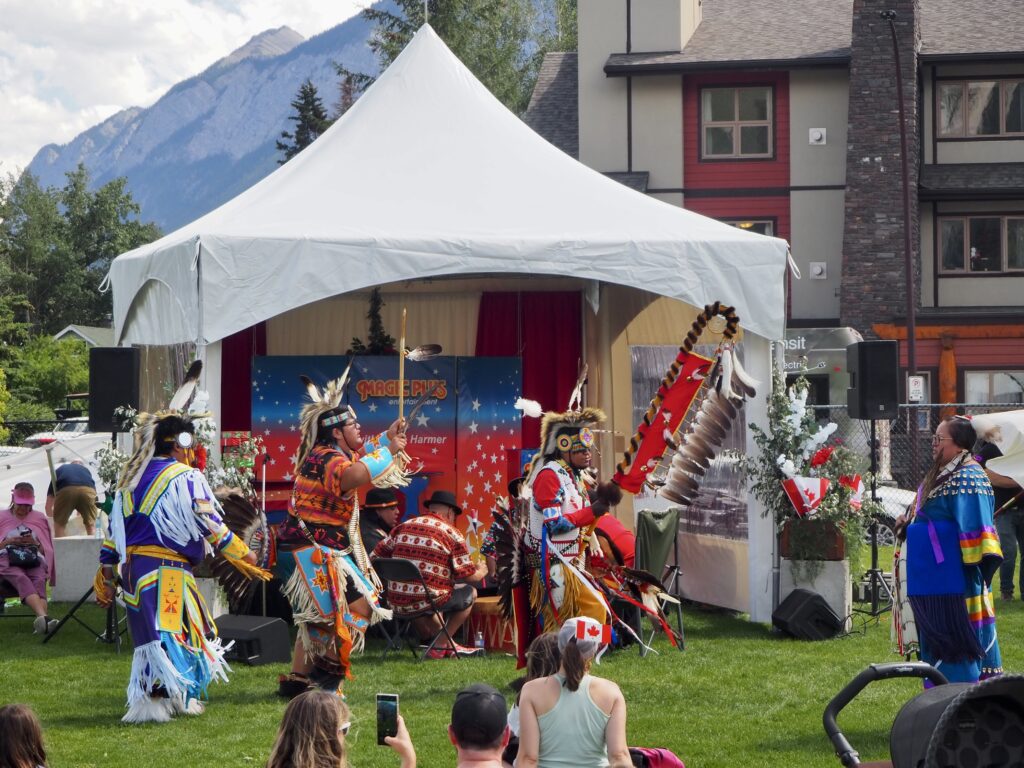
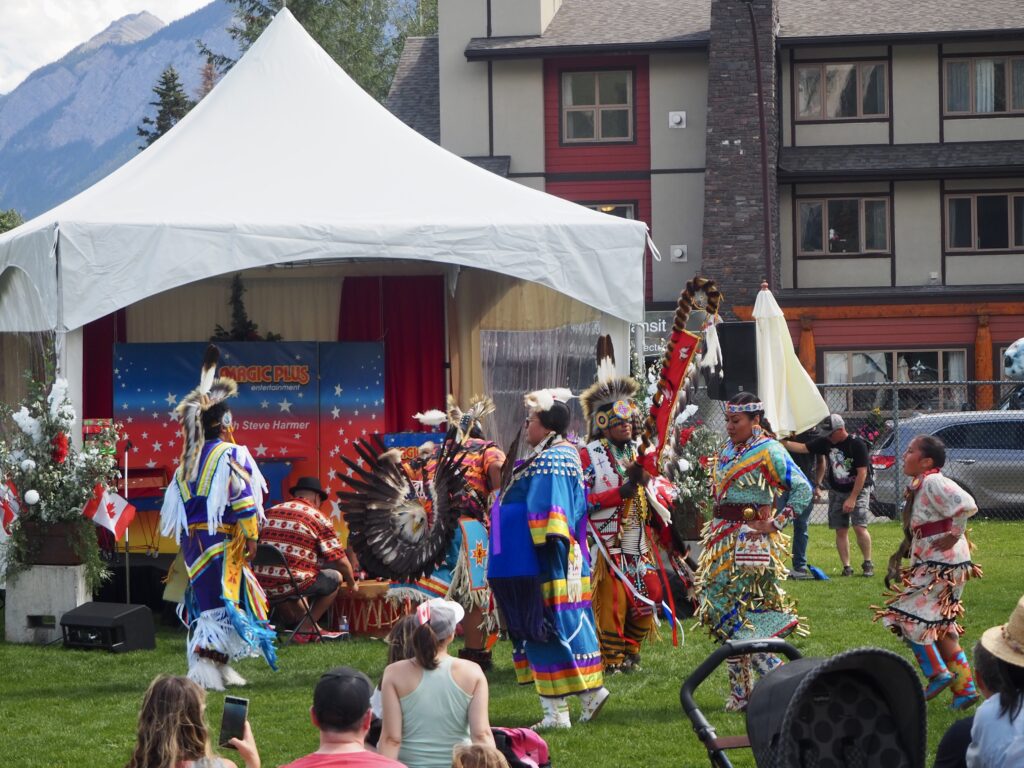
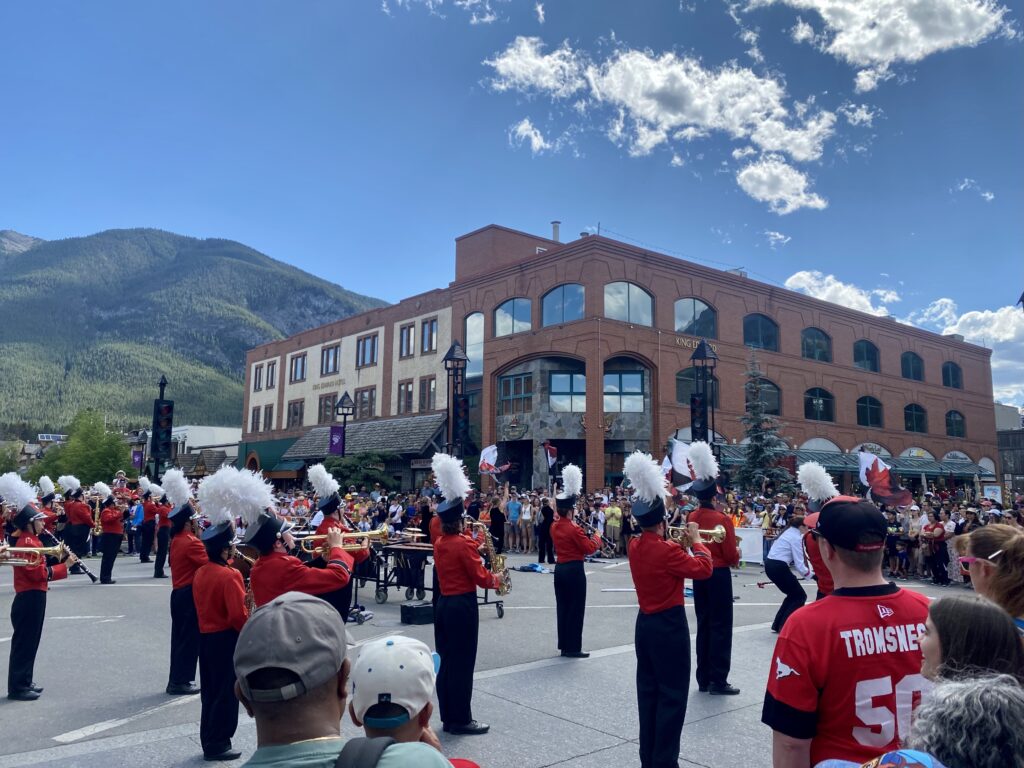
Cave and Basin Historic Site
So the whole reason we braved Banff town on Canada Day, was to visit the Cave and Basin Historic Site. Specifically, we were visiting it after hours on their lantern tour, which only runs certain days of the week, so it had to be today. We were a little bit concerned that it looked very closed and no one was around when we arrived, but the staff appeared and reopened for us at almost exactly the tour start time.
The Cave is where Banff National Park all started, a natural hot spring deep in the earth that European explorers found about a hundred years ago. Of course, the First Nations already knew about it! The lantern tour features staff in character as those same explorers, as they retell you how they found it. Your time in the cave start sin the dark, with just a singele lantern, but they turnon the other lights alter to let you see the whole thing. They also lift out a bucket of the spring water for you to dip your hand in and see how warm it is!
After the lantern portion, we exited the cave and watched a short video about the history of Parks Canada. Then our guide took us outside the Basin, another hot spring, which also has a very important snail population living in it! The whole tour took about an hour and finished up with some chamomile tea before we departed.
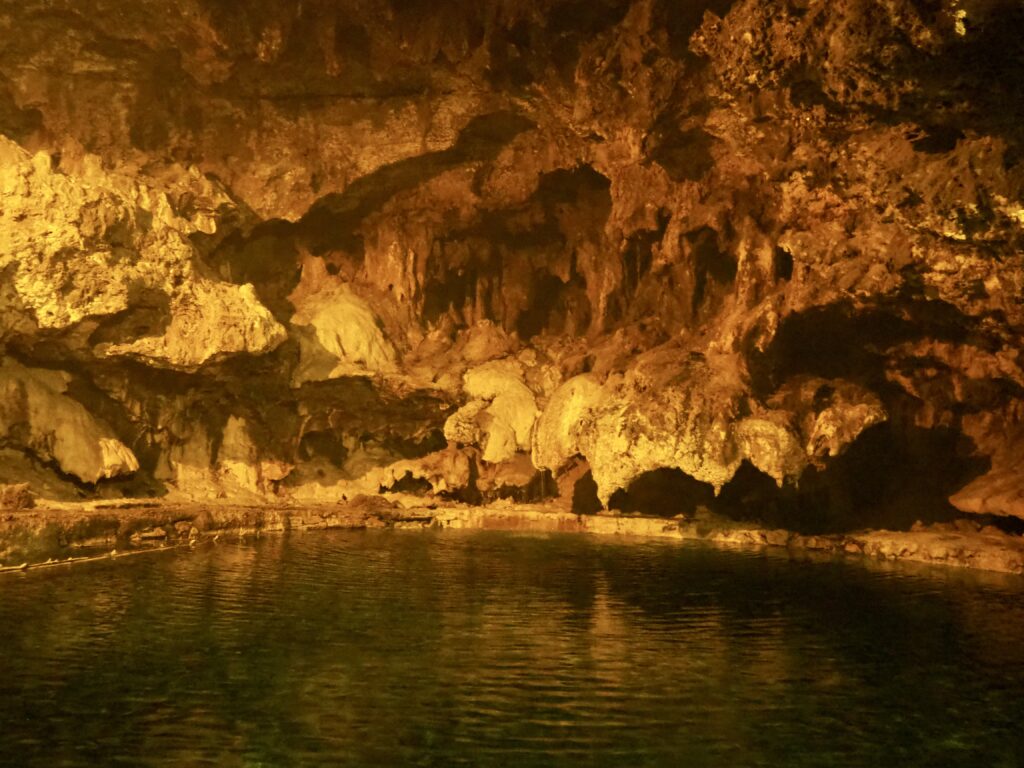
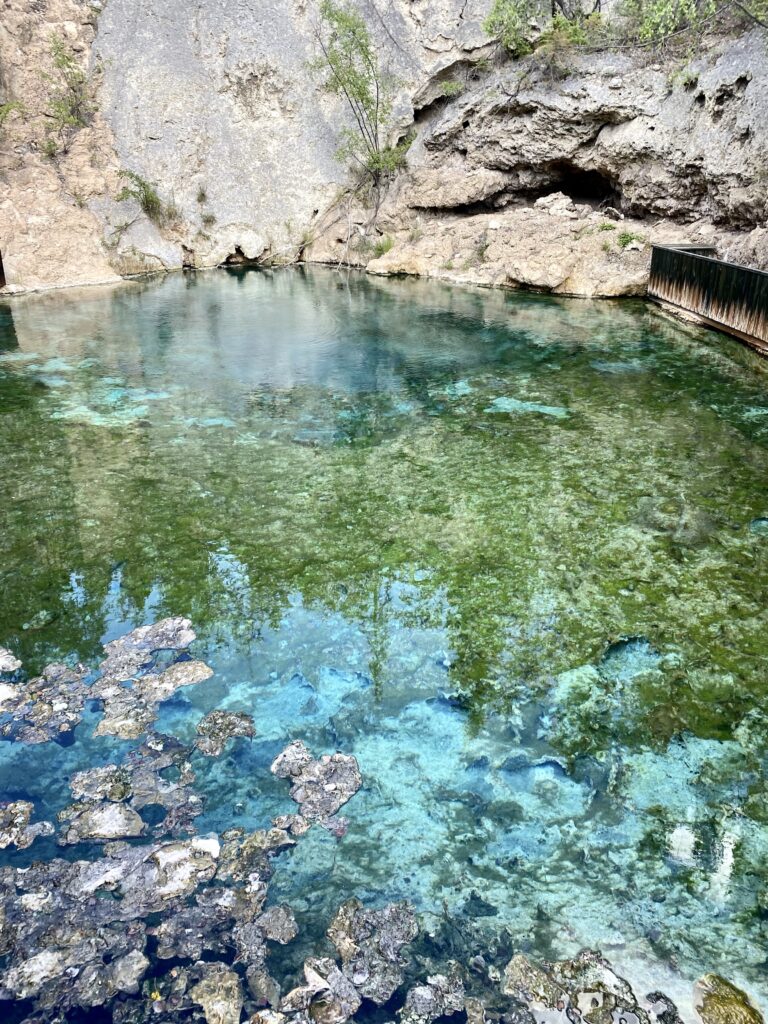
Day Five – Yoho National Park
Takakkaw Falls
Now, Jasper and Banff may be the most famous national parks, but their neighbour, Yoho should not be overlooked. It’s technically back in BC, so we crossed the border again, but it’s less than an hour’s drive from Lake Louise. Our first stop was Takakkaw Falls – yes, another waterfall! But this one is the second highest in all of Canada, so we couldn’t miss it (way higher than Niagara!). The drive was a bit of a hairy road, with a very tight switchback that I was glad I wasn’t driving for! It definitely felt a lot more remote driving up this narrow road away from the highway. But then you turn a corner and see this vast, wide gorge in front of you, with the waterfall tumblng down one side of it.
After parking, we followed the short path to the base of the falls. We were in awe as to where all the water was coming from, but the information boards soon revealed there is a glacier on the top that you can’t see from below. It really is an astonishing amount hurtling over the cliffside! The closer we got, we could soon feel the spray hitting our skin. By the time we were underneath it, I had to be fast snapping photos as my camera lens was covered in droplets in moments!
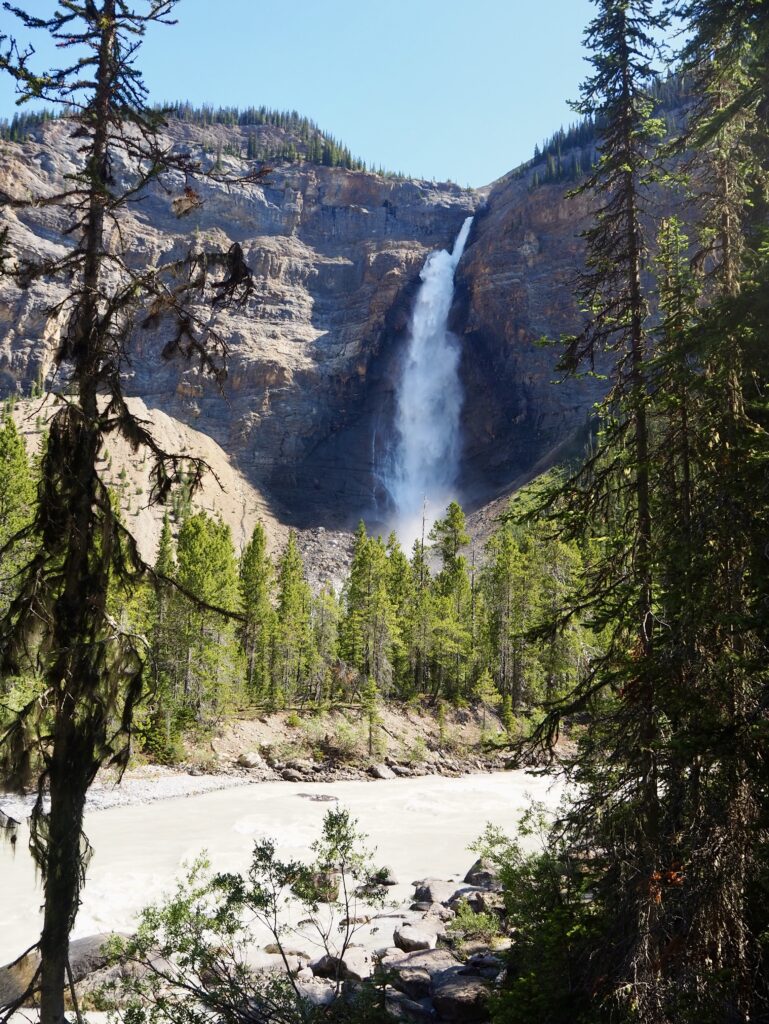
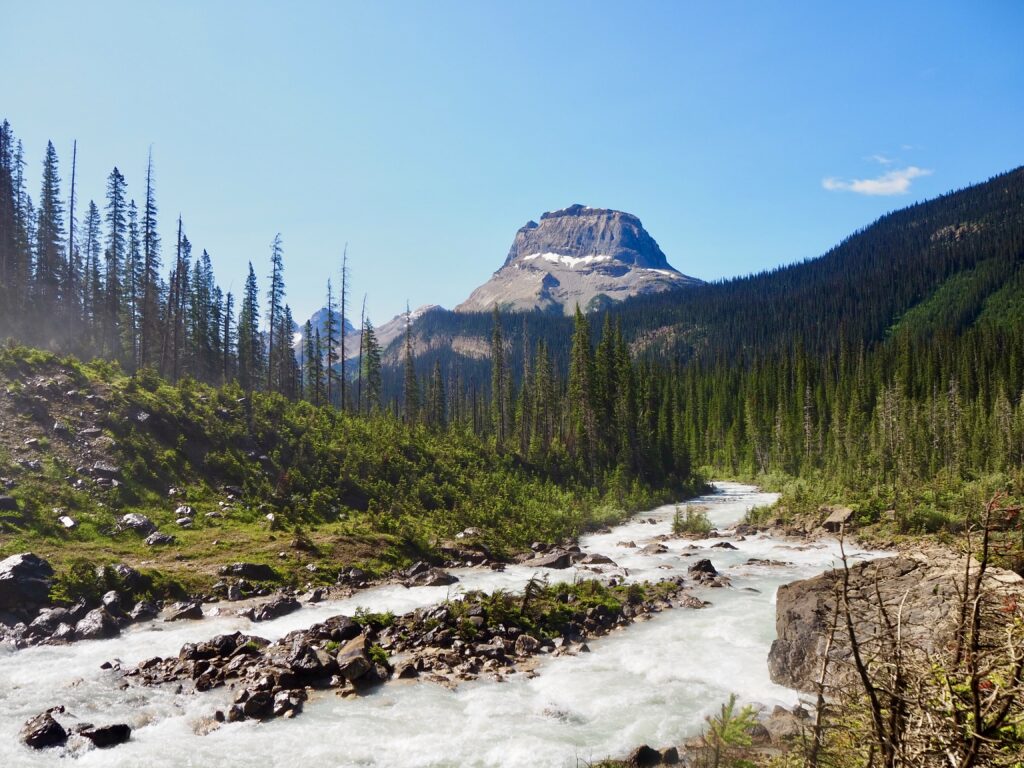
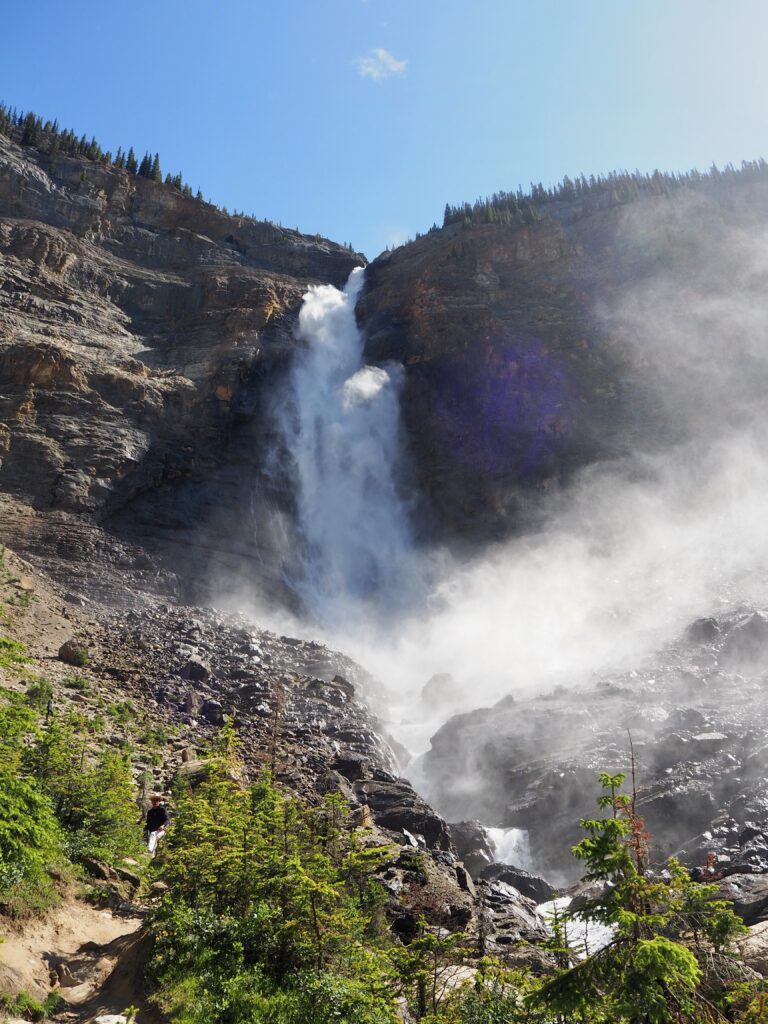
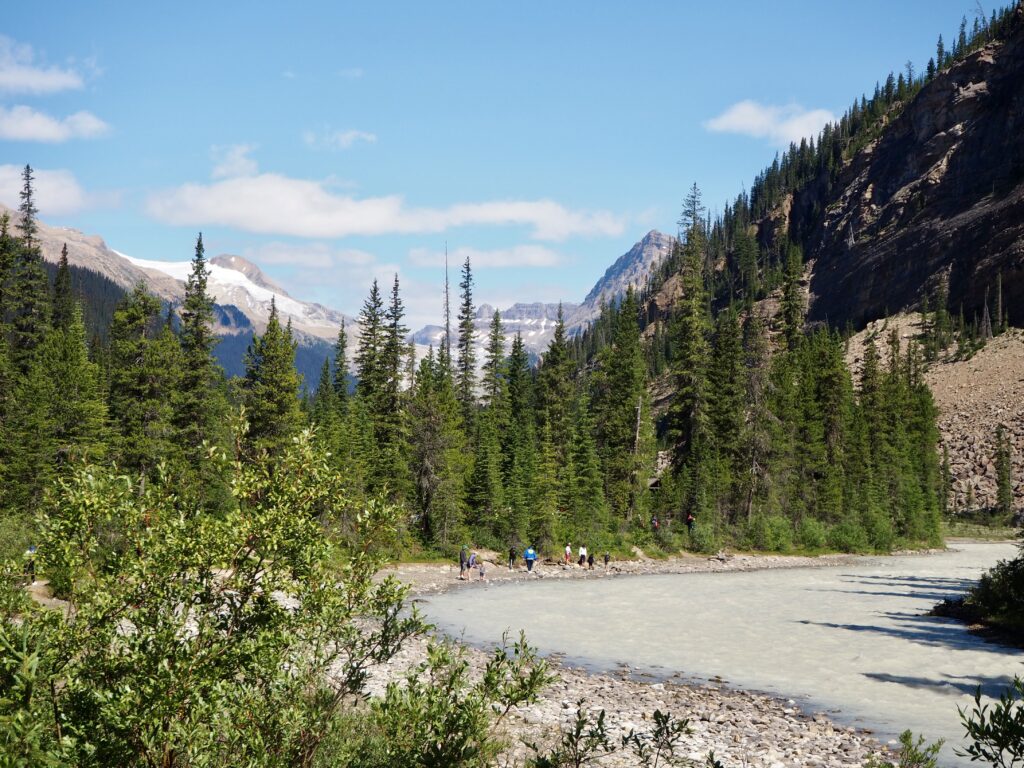
Natural Bridge
Returning to the highway, we continued further into Yoho before turning off to see the Natural Bridge. This stop was a little busier, but we still got parked pretty easily. As the name suggests, there is a natural bridge spanning the river here, a rock formation with a gap in the middle for the water. You aren’t allowed to actually walk on it, as this could damage the structure, esecially with so many tourists pssing through. But really, you can see it better from afar! There’s a regular bridge that crosses the river next to it, and platforms on each side, so you can admire it from all angles.
We also walked out to one of the low, flat rocks on the river’s edge, behind the natural bridge. From here, we could see the rapids of the river tumbling down towards it. The water was much browner here, not glacial blue, but that’s the rock flour getting tossed around in the current!
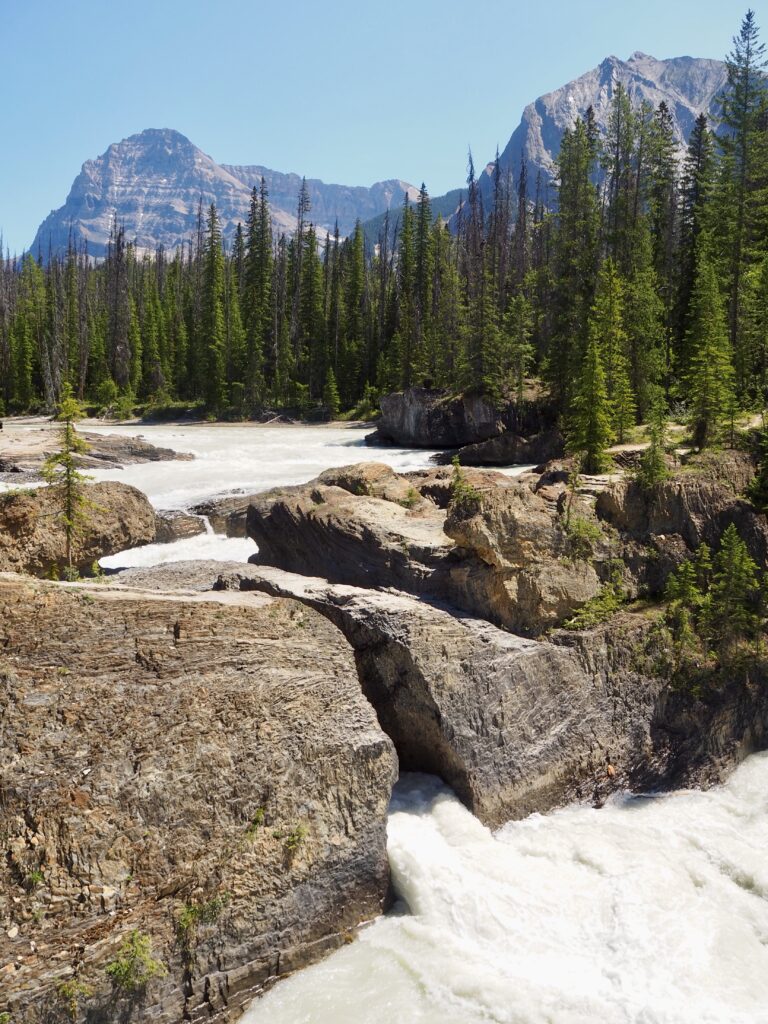
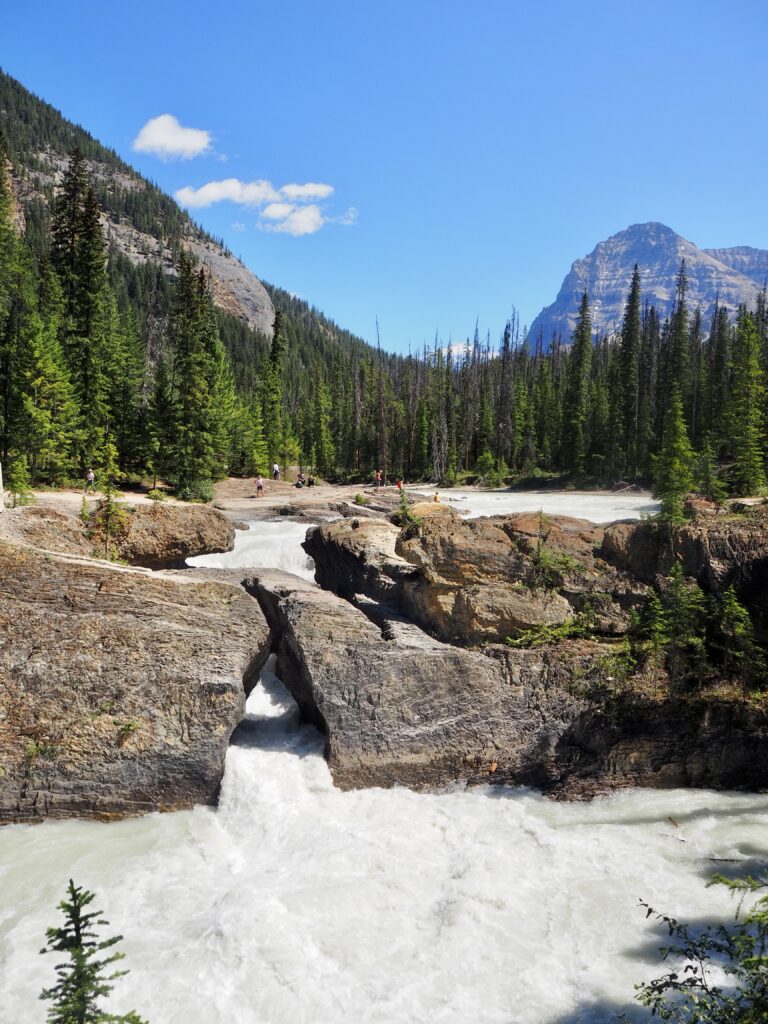
Emerald Lake
Next up was probably Yoho’s most famous site, Emerald Lake. I’d seen blogs that said it was possibly even more beautiful than Lake Louise or Moraine Lake! However, this was the parking from hell – it’s exploded in popularity in recent years, and the car park cannot keep up. People had just pulled over on the roadside for miles down from the lake, and you had to walk all the way back up. We snagged a spot as someone else was leaving, but nearly got cut-off in the process, so it was pretty stressful! I’d considered getting a canoe here too, since i didn’t at the other lakes, but the queue here was just as big, so I didn’t bother.
The lake is beautiful though, a stunning green colour as the name suggests, and milky with rock flour. The surrounding mountains are covered in evergreen trees, save for one spot where there are avalanches ever winter. We walked around until we found a vacant, quieter bit of bank to sit and have lunch by. And – guess what – I went for a paddle! We watched the many canoes drift by as well, people-watching their passengers. We then eded up walking all the way around the lake, passing by its glacial source and through the denser forest on the far side. The path was a lot quieter the furher you went from the car park, since not everyone will walk that far. I was a little disappointed by the crowds, as I’d thought Yoho would be quieter than Banff, but it was still beautiful nevertheless!
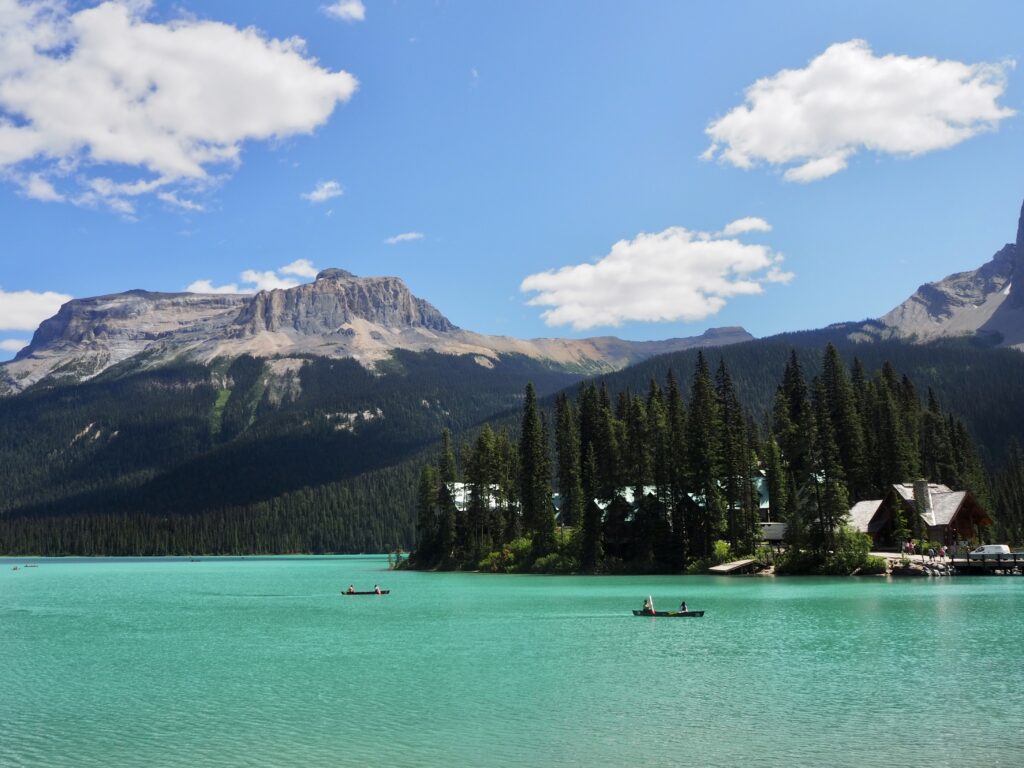
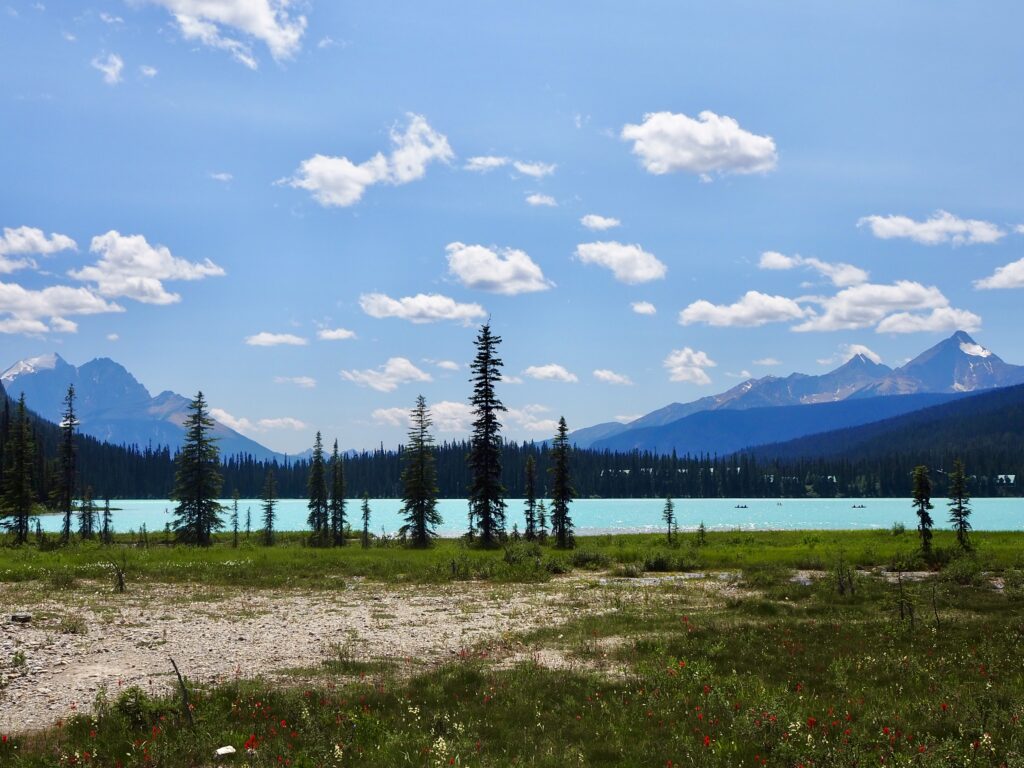
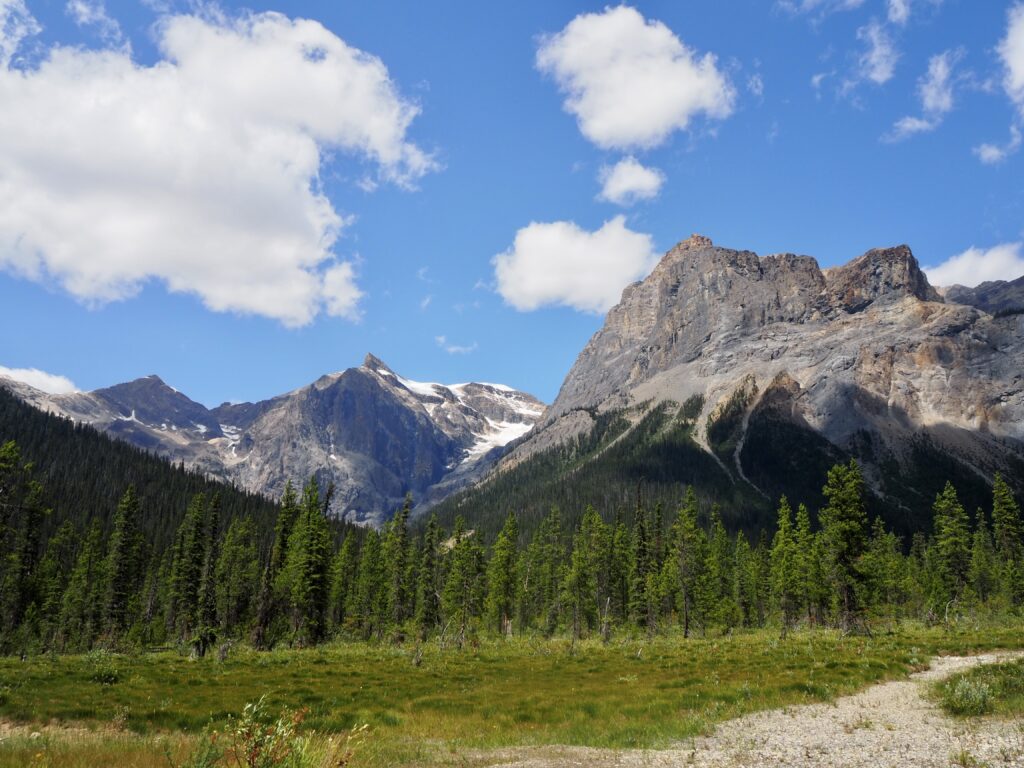
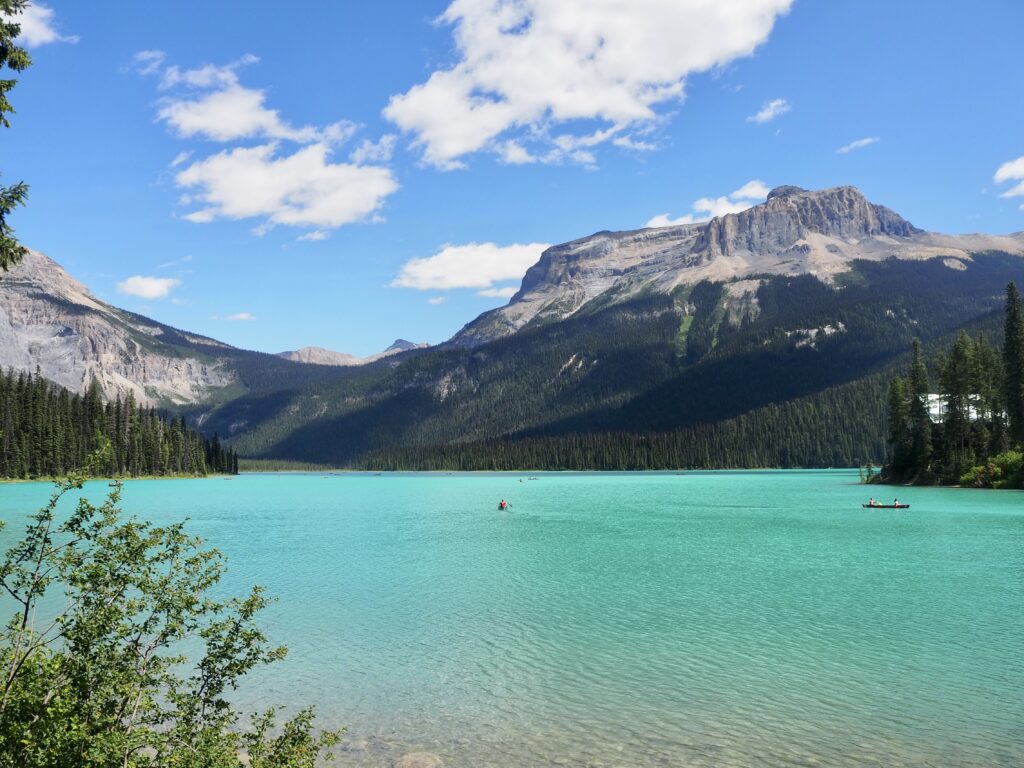
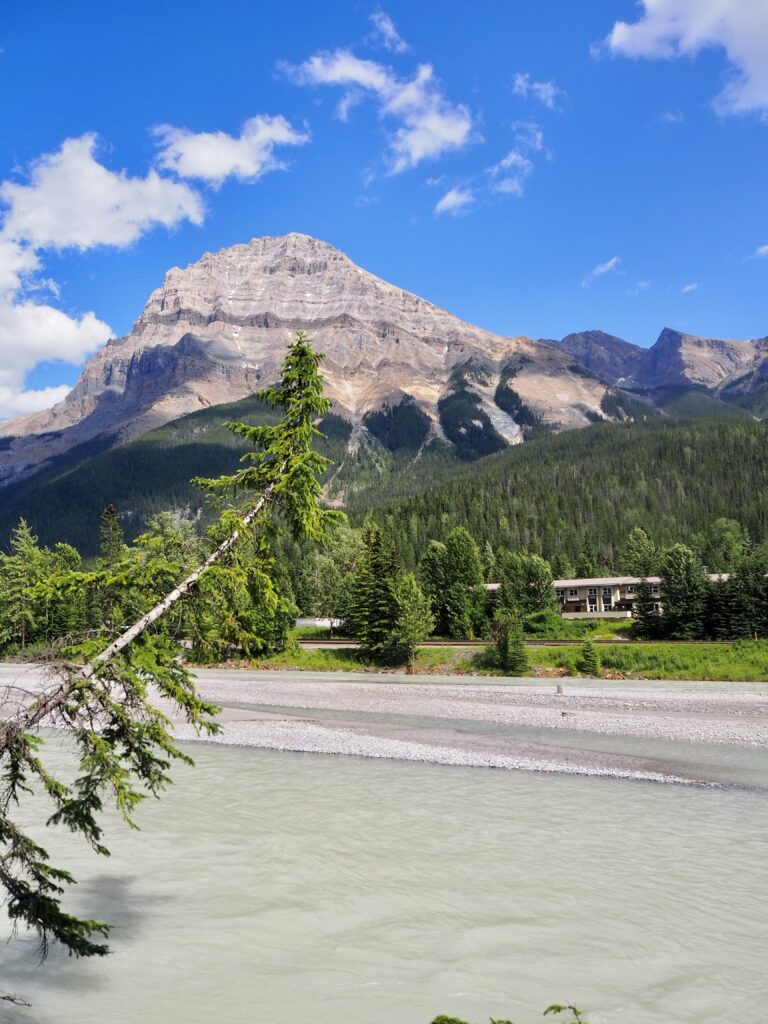
Lake Louise Station Restaurant
On our way back, we made a quick stop at the visitor centre in Field, the only real town in Yoho. It was mostly to use the bathroom, but there were some pretty interesting exhibits in there too! Notably, the tunnel loops carved in the mountainside to help the trains pass through with a lower risk of crashing. There was a model showing the route, and we kept our eyes peeled for the real thing on the drive back, but struggled to spot it. An interesting idea though!
The train theme continued back in Lake Louise for dinner. Dad had spotted something about a restaurant in a train station in one of the leaflets, which was a 20-minute or so walk from the hotel. Sure enough, the Station Restaurant is an old railway station converted into a restaurant, with many of its original features and loads of items and artefacts from the area’s history as a resort. You can even dine in one of the old train dining carriages outside, but that’s a set menu and you have to book in advance. We enjoyed the station anyway, and I was enthralled looking at all the items there!
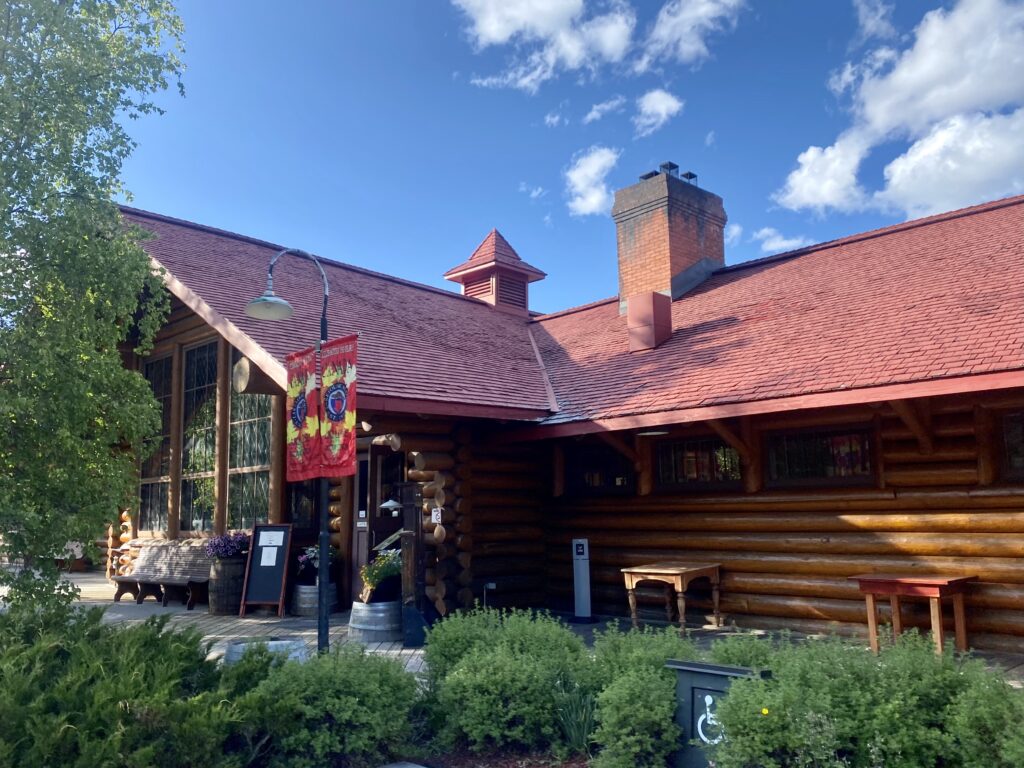
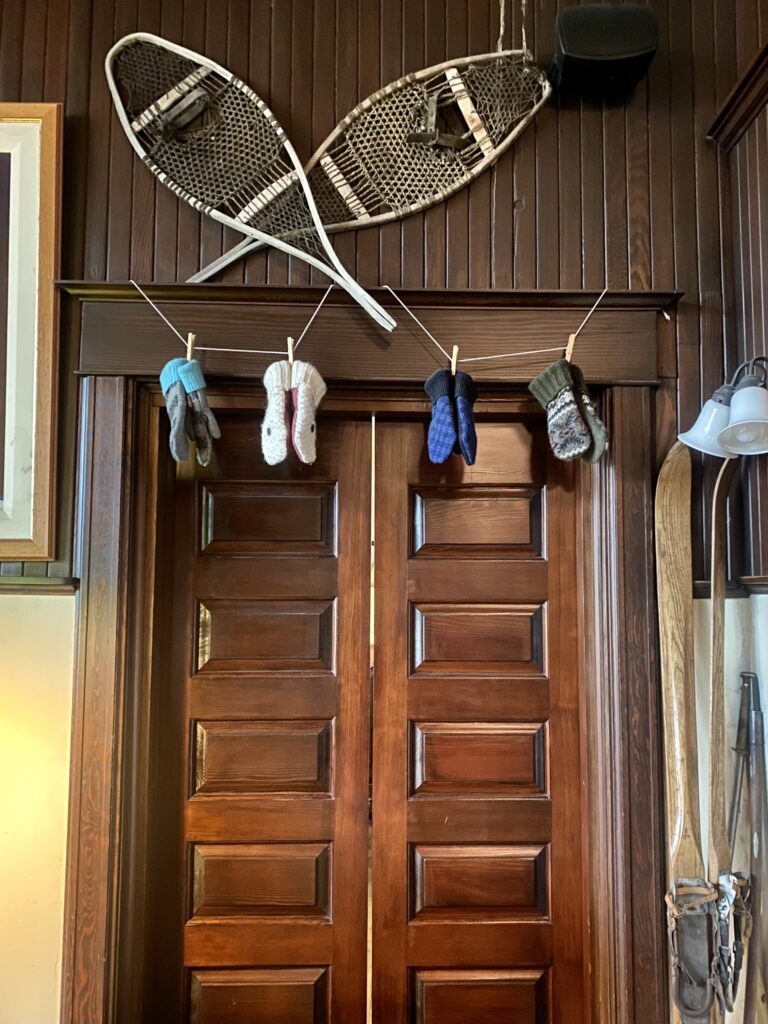
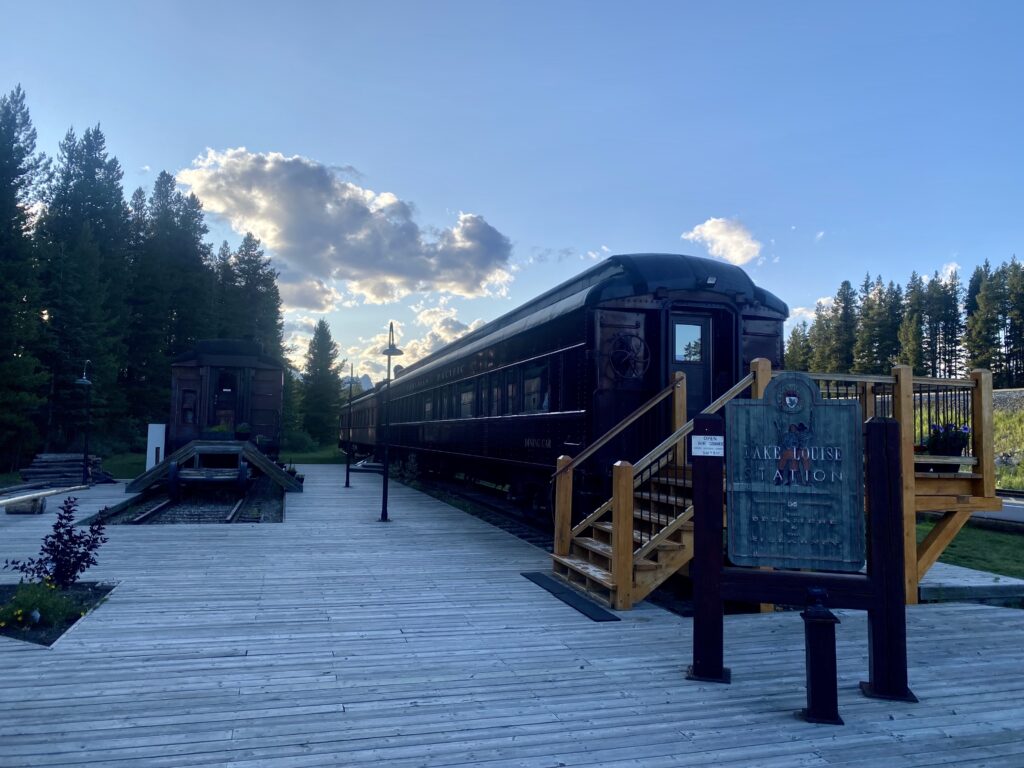
Day Six
Banff Upper Hot Springs
That was the end of our time in Lake Lousie, as we continued on to Canmore the next day. But, we did make a return to Banff later in the week to visit the Upper Hot Springs. We missed the Miette Hot Springs in Jasper as the road was closed due to snow, so we wanted to visit at least one. The springs come from Sulphur Mountain, up above the town, and the parking is near tthe gondola too. The hot spring was been fed into a swimming pool, and the water is chlorinated for sanitary reasons. But the heat is all natural!
It was busy, so we had to queue to get in, but it didn’t take too long fortunately. There were a lot of kids splashing, but it’s really a pool for soaking, not swimming. We found a spot to sit on a ledge by the side, and while away the time just lounging and chatting. There was the risk of it closing if it started to rain, which it was when we arrived, but the weather soon passed and they stayed open. It also meant the skies cleared enough for us to see some of the view from the mountain side on our way out afterwards as well. The minerals are supposed to be great for healing, though I think you need more than one visit to notice the effect! It was a nice, rainy evening activity anyway.
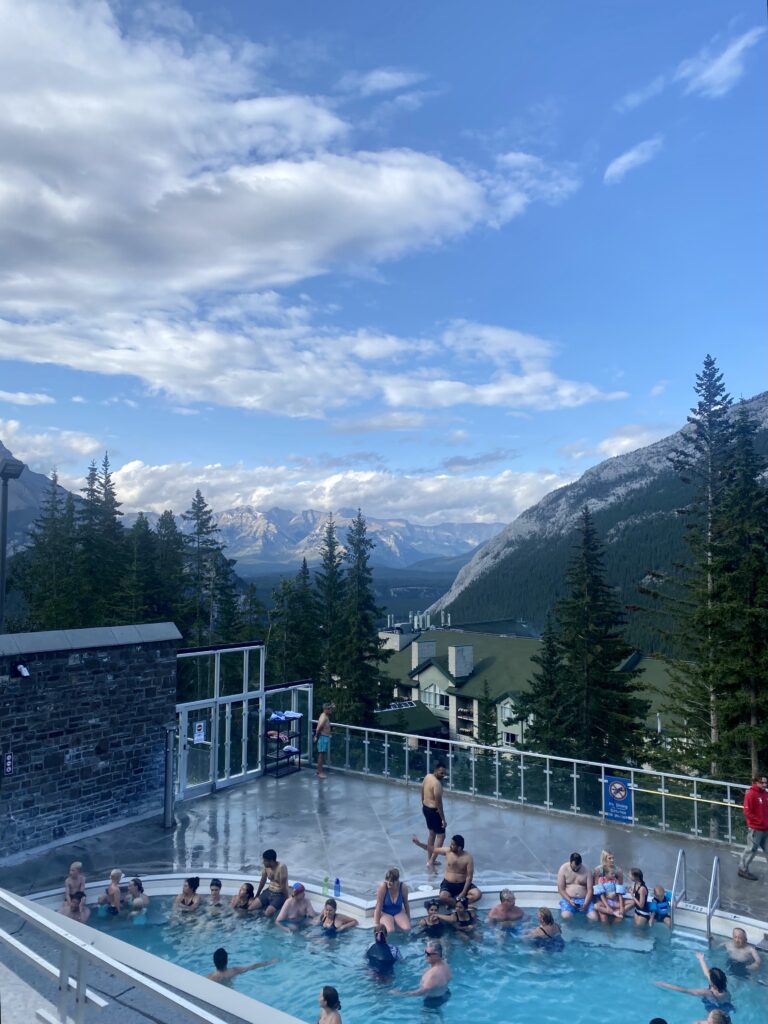
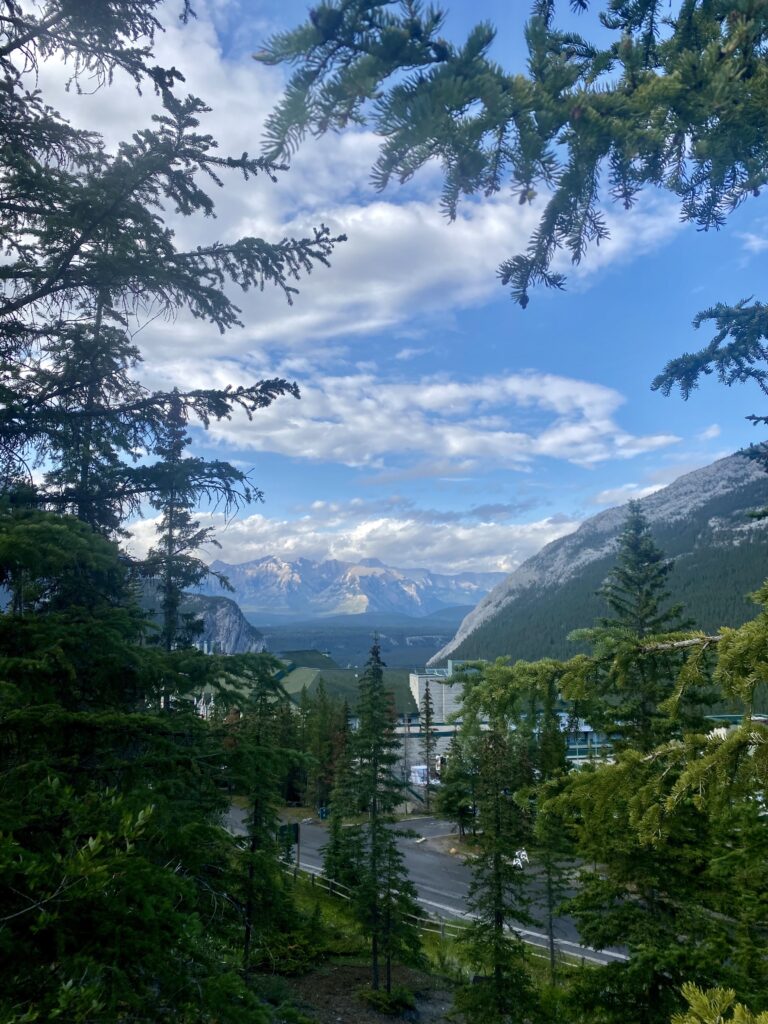
Day Seven
Canmore & Sauvage Restaurant
Canmore itself is a slightly bigger town and while it does cater to tourists, it feels a little more local and lived-in, being outside Banff National Park. I did take it as an opportunity to rest for a few days, after such a busy few weeks. We went for a wander one evening after work though, following the Policeman’s Creek Boardwalk trail along the riverside, over the top of the surrounding wetland. The main street in Canmore has quite a few nice shops, including a lot of locally-made goods. I was tempted by a few things, as I always am, but restrained myself and settled on a pair of beaded First Nations-crafted earrings.
That evening was also Dad’s birthday and Mum had booked Sauvage restaurant for a meal out, which I paid for as his gift. I’m not usually a big foodie, but the restaurant has a female chef who uses all locally grown or foraged, seasonal ingredients, so a big focus on sustainability. Right up my street! We had a seven course tasting menu with wine pairings, me taking the ‘gatherer’ vegetarian option, while they both had the ‘hunter’ menu with meat. There were so many interesting ingredients used, including lots of wild flowers and leaves I’d have never though of. Even the wines were very unique, in where they came from or how they were made. And of course it was all delicious!
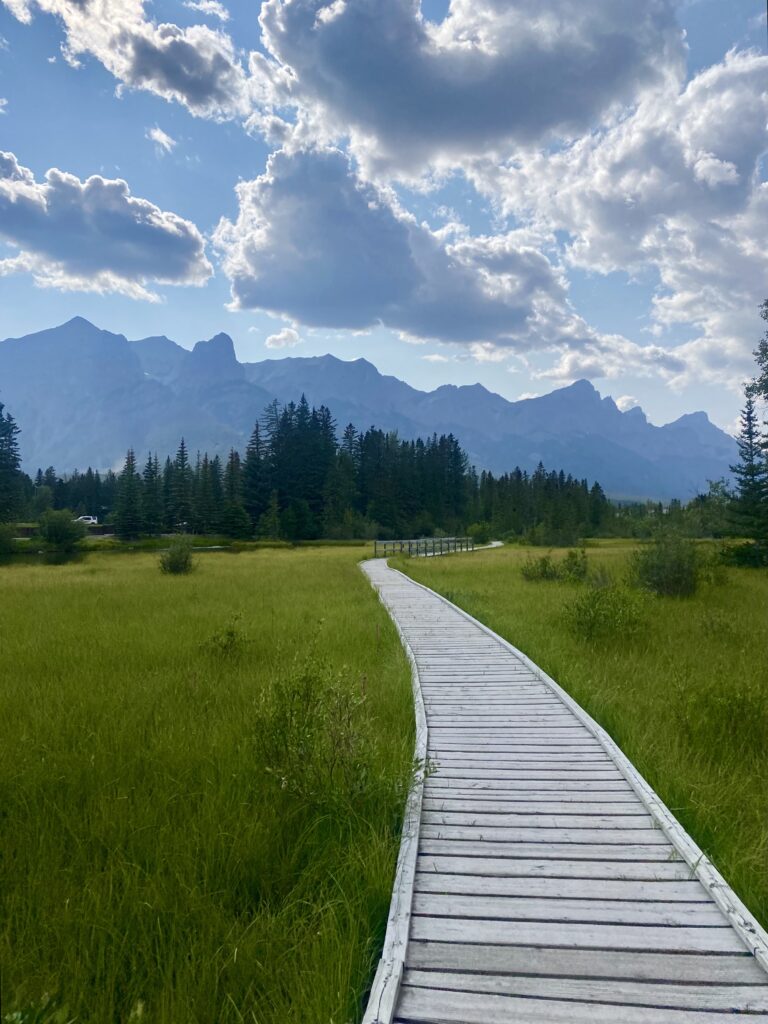

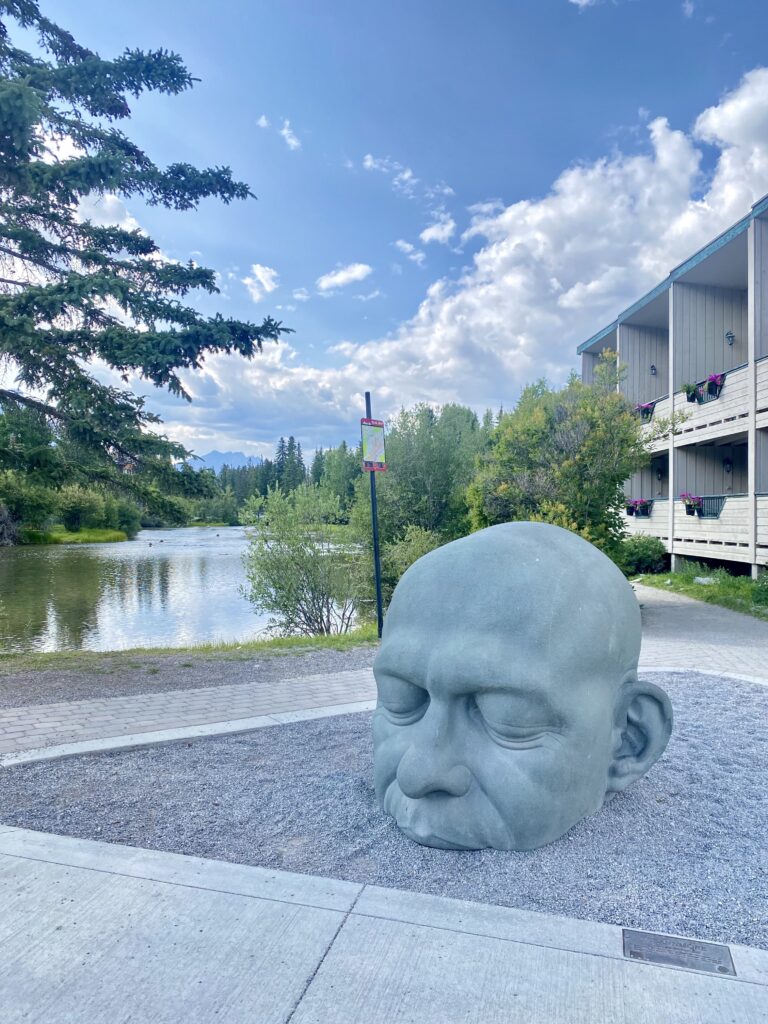

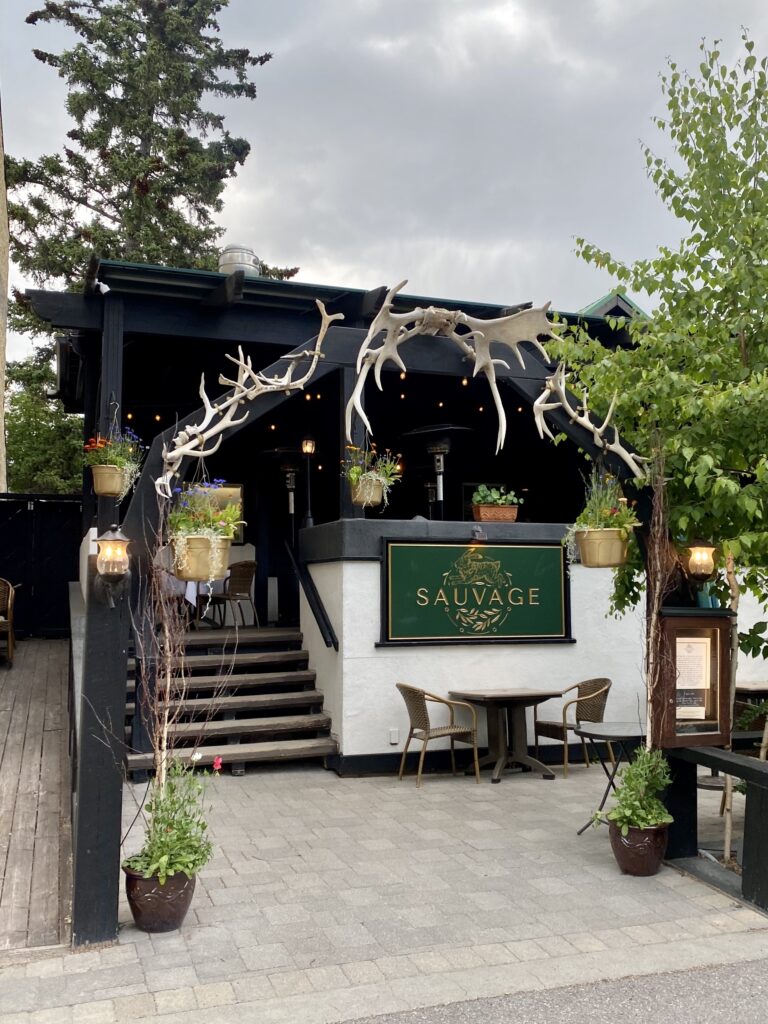
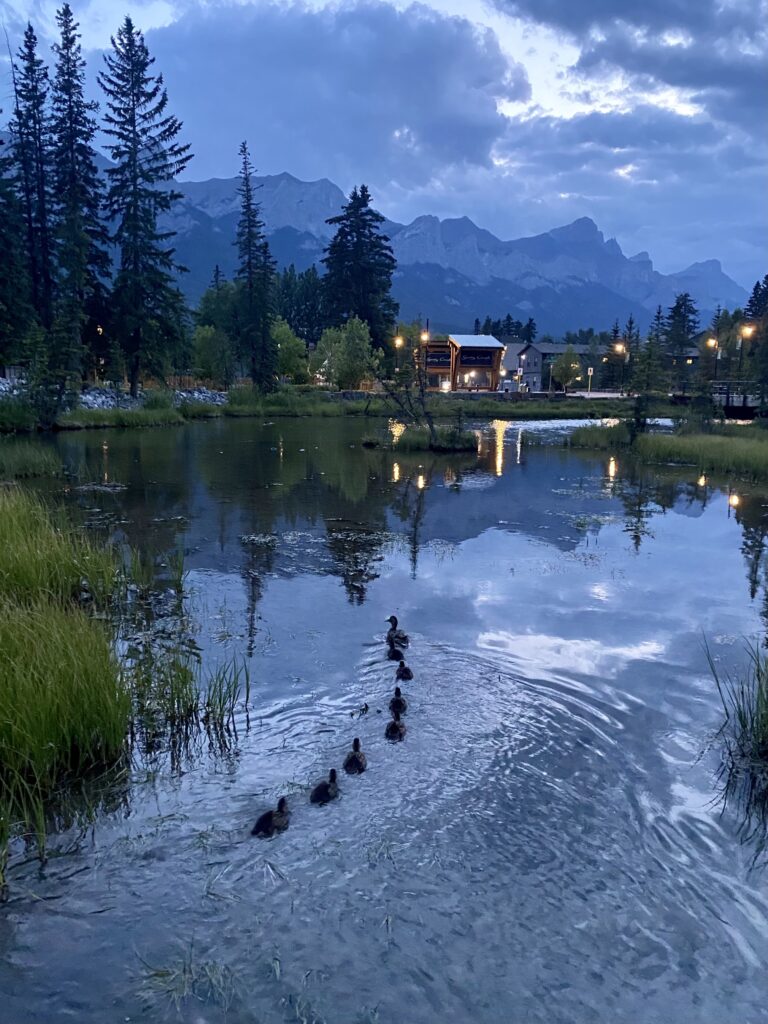
Banff & Yoho National Park
Banff and Yoho National Parks were absolutely incredible! Yes, they were super busy and I would have preferred to go at a less hectic time. Though I was glad to see the Canada Day events in Banff while we were there! And summer meant the weather was on our side with lots of sunny days, the lakes were fully melted and blue, and the extra day off work was a bonus. The scenery is just beautiful and it’s easy to understand why these are such famous, popular parks for Canadian and foreign visitors alike. Of course, there’s lots of hiking for outdoorsy, active people, and plenty wildlife spotting opportunities. We almost had a ground squirrel come inside our room at one point! But you can also take it easy and relax too. After Canmore, we left the Canadian Rockies and continued through Alberta to the city of Calgary.
You May Also Like
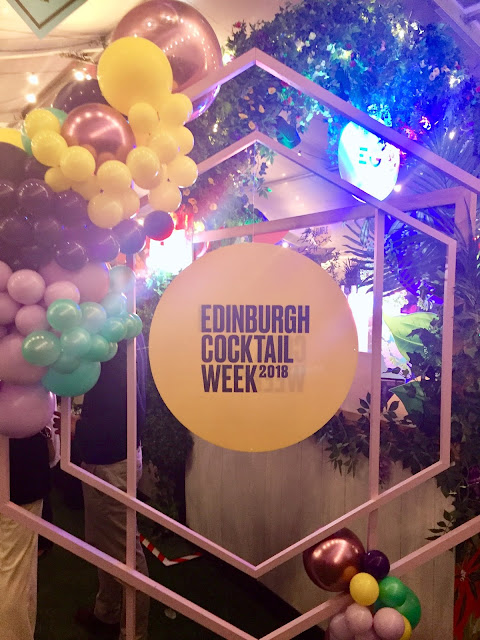
Edinburgh Cocktail Week
20 October 2018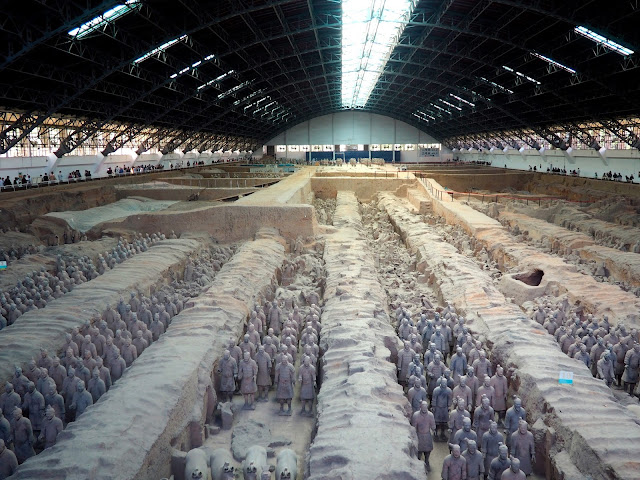
Xian Highlights | China
25 April 2017